





































SCAN TO SEE THE LAUNCH HIGHLIGHTS OF OPPO FIND X5 PRO VIA A SPECIAL AUGMENTED REALITY EXPERIENCE gulfbusiness.com / JULY 2022 OPPO AND HASSELBLAD’S BLEND OF THE CLASSIC AND CONTEMPORARY IN THE LATEST FIND X5 PRO AIMS TO CHANGE THE WAY PEOPLE CAPTURE MOMENTS MOMENT EVERY EMPOWER SPECIAL REPORT: THE CHANGING WORLD OF LOGISTICS AND SUPPLY CHAIN P.62 REIMAGINING HOSPITALITY: How Al Habtoor City Hotel Collection has redefined luxury P.36 ALL IN THE FAMILY: The legacy driving the UAE’s leading family businesses BD 2.10 KD 1.70 RO 2.10 SR 20 DHS 20
The best outcomes are made possible when everything comes together. A proven past, with an eye on the future. Diverse perspectives, that see all the possibilities. We have a history of looking to the future and over 3,000 solutions globally.
Let’s advance together.

Advance together
Issued by Invesco Asset Management Limited. PO Box 506599, DIFC Precinct Building No 4, Level 3, Office 305, Dubai, UAE. Regulated by the Dubai Financial Services Authority.
Gulf Business
07
The brief
An insight into the news and trends shaping the region with perceptive commentary and analysis
28
Where classic meets contemporary
With a custom IMX709 sensor in its front camera, OPPO’s Find X5

Pro ensures selfies look better than ever, with improved texture and more accurate colour reproduction – even in challenging light conditions
36
Family ties
Family businesses have long played an important role in the region’s economic development

gulfbusiness.com July 2022 3
CONTENTS / JULY 2022
Exclusive paintings, sculptures, photography and timepieces from award-winning international artists.










 The United Arab Emirates 50th Anniversary Navigator Clock – Limited Edition by David Galbraith
Painting by Sonu Sultania
Photograph by Jorge Ferrari
The United Arab Emirates 50th Anniversary Navigator Clock – Limited Edition by David Galbraith
Painting by Sonu Sultania
Photograph by Jorge Ferrari
Shopping bonanza: All set for Dubai Summer Surprises and its great offers p.60

“Expo City
memories in
Luxe all the way: Dubai’s Al Habtoor City Hotel Collection showcased p.62

Healing retreat: What makes Switzerland an ideal healthcare destination p.66

69
The SME Story
with
and
General manager – production S Sunil Kumar

Production manager Binu Purandaran Production supervisor Venita Pinto
Chief commercial officer Anthony Milne anthony@motivate.ae
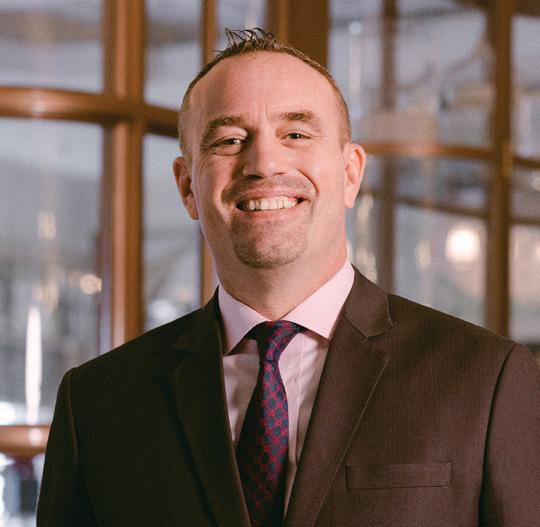
Publisher Manish Chopra manish.chopra@motivate.ae
Sales executive Sonam Sharma sonam.sharma@motivate.ae
Group marketing manager Joelle AlBeaino joelle.albeaino@motivate.ae
Group marketing manager Dominic Clerici dominic.clerici@motivate.ae
gulfbusiness.com July 2022 5
Dubai will be an environmentally-friendly city that caters to families and future generations. A city connected to a port and two airports, and also to beautiful
the hearts and minds of millions of people” HH
Sheikh Mohammed bin Rashid Al Maktoum, Vice President and Prime Minister of the
UAE
and Ruler of Dubai
59 Lifestyle
Interviews
entrepreneurs
insights from experts on how the regional SME ecosytem is evolving HEAD OFFICE: Media One Tower, Dubai Media City, PO Box 2331, Dubai, UAE, Tel: +971 4 427 3000, Fax: +971 4 428 2260, motivate@motivate.ae DUBAI MEDIA CITY: SD 2-94, 2nd Floor, Building 2, Dubai, UAE, Tel: +971 4 390 3550, Fax: +971 4 390 4845 ABU DHABI: PO Box 43072, UAE, Tel: +971 2 677 2005, Fax: +971 2 677 0124, motivate-adh@motivate.ae LONDON: Acre House, 11/15 William Road, London NW1 3ER, UK, motivateuk@motivate.ae Follow us on social media: Linkedin: Gulf Business Facebook: GulfBusiness Twitter: @GulfBusiness Instagram: @GulfBusiness Cover: Freddie N. Colinares Editor-in-chief Obaid Humaid Al Tayer Managing partner and group editor Ian Fairservice Group director Andrew Wingrove andrew.wingrove@motivate.ae Editor Neesha Salian neesha.salian@motivate.ae Digital Editor Zubina Ahmed zubina.ahmed@motivate.ae Tech editor Divsha Bhat divsha.bhat@motivate.ae Contributor Zainab Mansoor editorial.freelancer@motivate.ae zzainabmansoor Senior art director Olga Petroff olga.petroff@motivate.ae Art director Freddie N. Colinares freddie@motivate.ae Photographer Mark Mathew
CONTENTS / JULY 2022

Revolutionary, new out-of-home (OOH) advertising medium, powered by innovative technology. This unique and globally patented Escalator Step Branding Solution gives brands an unrivaled opportunity to connect with audiences across the GCC. CONTACT US TODAY sales@motivate.ae +971 4 427 3000
Steady course

gulfbusiness.com July 2022 7 Climate Action 08 Construction 12 Investment 14 Calev’s Newsroom 18 Productivity 20 JULY
Local and regional banking ecosystems have remained resilient despite challenges p.10 22 The Brief Source: State of the Global Islamic Economy report 2022 INVESTMENTS Halal food tech platforms (such as online delivery apps and cloud kitchens) will continue to generate investments German food delivery service Delivery Hero acquired UAE online grocery platform Instashop Countries with number of related deals in 2020/21 11 UAE 12 Malaysia 39 Others14 Indonesia
Can hydrogen make climate change worse?
She and others sounding this alarm insist it’s no reason to give up on hydrogen. Rather, hydrogen’s heat-trapping power means any future system for producing, distributing and using the gas must be built to minimise leaks.
“There is great potential using hydro gen to save a lot of emissions of carbon dioxide, but it’s really important to keep the hydrogen leakage rates down,” says Nicola Warwick, lead author of the UK study and a National Centre for Atmos pheric Science research scientist at the University of Cambridge.
Aworld
desperate for a climatefriendly fuel is pinning its hopes on hydrogen, seeing it as a way to power factories, buildings, ships and planes without pumping carbon dioxide into the sky.
But now scientists are warning that hydrogen leaked into the atmosphere can contribute to climate change much like carbon. Depending on how it’s made, dis tributed and used, it could even make warming worse over the next few decades, even if carbon poses the bigger long-term threat. Any future hydrogen-based econ omy, they say, must be designed from the start to keep leaks of the gas to a minimum, or it risks adding to the very problem it’s supposed to solve. Some ideas now being tested, like shipping hydrogen in pipelines built to hold natural gas or burning it in individual homes, could cause an unaccep table level of leaks.
“The potency is a lot stronger than people realise,” says Ilissa Ocko, a climate scientist with the Environmental Defense Fund (EDF), a non-profit group. “We’re putting this on everyone’s radar now not to say ‘no’ to hydrogen but to think about how we deploy it.”
Hydrogen doesn’t trap heat directly, the way CO₂ does. Instead, when leaked it sets off a series of chemical reactions that warm the air, acting as an indirect green house gas. And though it cycles out of the atmosphere far faster than carbon diox ide, which lingers for centuries, it can do more damage than CO₂ in the short term.
Over 20 years, it has 33 times the global warming potential of an equal amount of carbon dioxide, according to a recent UK government report. Over hundreds of years, carbon is more dangerous, due to its longevity.
Hydrogen’s warming potential was never a problem before, as its use was largely limited to oil refineries and chemical or fertiliser plants. But now governments worldwide are investing billions to build a hydrogen economy, seeing the gas as one of the only options for decarbonising many industries that can’t easily run on electricity. President Joe Biden has set aside $8 billion to build at least four “hydrogen hubs” where the fuel will be produced and used, and states are gearing up to compete. US utility companies that now deliver natural gas see it as a savior, announcing more than two dozen hydrogen pilot projects in the last two years.
“Now is when decisions are being made, and money’s being spent,” Ocko says. “We can get ahead of this issue now, so it doesn’t become a problem.”
The hydrogen industry acknowledges the problem, even if companies disagree on the potential scope. Dave Edwards, with industrial gas company Air Liquide, said the effects of hydrogen leaks on the atmosphere should be far less than the tra ditional fuels they displace. Running cars and trucks on hydrogen fuel cells would have less atmospheric impact than run ning them on gasoline and diesel, even if the system for making and delivering that hydrogen leaks.
“It doesn’t mean it’s not still important, it doesn’t mean we don’t need to understand more about it, but our first impression is it’s much, much smaller,” says Edwards, a director with the company and its chief hydrogen advocate in the US. Hydrogen leaks, he says, “are manageable problems to address.”
Hydrogen has big advantages as a clean fuel. Burn hydrogen in a turbine, and it will generate power without carbon dioxide. Run it through a fuel cell, and it will produce electricity with water vapour as the only exhaust. Unlike solar and wind power, it can be stored in large amounts for when it’s needed. While the vast majority of the hydrogen produced today is stripped from natural gas, in a process that releases
gulfbusiness.com8 July 2022 The Brief / Climate Action ANALYSIS
“HYDROGEN HAS BIG ADVANTAGES AS A CLEAN FUEL. BURN HYDROGEN IN A TURBINE, AND IT WILL GENERATE POWER WITHOUT CARBON DIOXIDE. RUN IT THROUGH A FUEL CELL, AND IT WILL PRODUCE ELECTRICITY WITH WATER VAPOR AS THE ONLY EXHAUST”
There is great potential in using hydrogen to save a lot of carbon dioxide emissions, but it’s really important to keep the hydrogen leakage rates down
carbon dioxide, it can also be separated from water using renewable power, with no emissions but oxygen.
But for all its benefits, hydrogen can also slip easily through equipment designed to contain larger molecules like the methane in natural gas.
Once it escapes, much of the leaked hydrogen will be absorbed by microbes in the soil. Some of what’s left in the air will react with a substance that helps remove methane from the atmosphere. That’s a problem, because methane is itself a powerful greenhouse gas, with more than 80 times the global warming potential of carbon dioxide over 20 years. The reac tion between hydrogen and that substance — known as the hydroxyl radical, or OH — leaves less of the OH available to react with methane. So methane entering the atmos phere will stick around longer and do more damage than it would have if the hydrogen hadn’t been there.
Leaked hydrogen has other warming effects as well. In the troposphere, the atmospheric layer closest to the ground, it triggers a chain of chemical reactions that produce more ozone, another greenhouse gas and a key component of smog. Much higher up, in the stratosphere, the hydrogen leads to an increase in water vapour, which has the overall effect of trapping more thermal energy in the atmosphere.
These reactions happen over a short time span – a handful of years. Excess carbon dioxide, in contrast, builds up atmospheric heat over centuries. But with temperatures quickly rising worldwide, scientists say short-term drivers of climate change can’t be ignored.
“These decades matter,” says Steven Hamburg, EDF’s chief scientist. His group has been trying to raise the issue of hydro gen’s warming potential with anyone who’ll listen, briefing academics, businesses and the US Department of Energy. His col league, Ocko, estimates they’ve met with some 200 people to date. For EDF, it’s a logical extension of the group’s work trying to direct public attention to short-term cli mate pollutants like methane and black carbon, which often get overlooked in the focus on carbon dioxide.
Many utility companies are experiment ing with blending hydrogen into their existing natural gas pipelines, sprawling networks that feed everything from power plants to household stoves. To Hamburg,

$8bn
to build at least four “hydrogen hubs” where the fuel will be produced and used
that’s a recipe for leaks. He also warns that mass-producing hydrogen from fossil fuels could even lead to a short-term increase in warming, if the systems for making and transporting the hydrogen leak enough hydrogen and methane. There would still be a long-term benefit from cutting carbon dioxide emissions, but over the span of a decade or two, a leaky hydrogen system based on fossil fuels could cause more warming than business as usual.
“Over several decades, you could be worse off – it’s very plausible,” Hamburg says.
The issue hasn’t stopped gas utilities from exploring hydrogen blending projects. But it may become one of the things those projects study. California utility PG&E Corporation, in May, announced plans to try different blends of hydrogen and natural gas in a dedicated pipeline system separate from the company’s usual gas transmission network, with the blends burned in a power plant south of Sacramento. The company’s spokeswoman Melissa Subbotin says the company’s “Hydrogen to Infinity” project will examine the potential for leaks.
“Extensive research needs to be done to understand the feasibility of hydro gen injection within a natural gas pipeline system,” she wrote in an email.
A hydrogen economy riddled with leaks would just undercut its own effectiveness, Hamburg says, delivering less of a blow against climate change than it could.
Clean-energy advocates point to how methane leaking from natural gas wells and pipelines – leaking that turned out to be far more widespread than once believed –undermined some of the benefits of shifting power plants from coal to gas. They don’t want that to happen with hydrogen.
“We’re at risk of proceeding with the build-out of new infrastructure that’s essen tially going to repeat all those past harms,” says Julie McNamara, deputy policy direc tor for climate and energy with the Union of Concerned Scientists. “We don’t have the time or luxury to get it wrong.” Bloomberg
gulfbusiness.com July 2022 9
OVER 20 YEARS, HYDROGEN HAS 33 TIMES
THE GLOBAL WARMING POTENTIAL OF AN EQUAL AMOUNT OF CARBON DIOXIDE
US President Joe Biden has set aside
Steady course
Thetraditional banking landscape has experienced a notable change, driven by escalating consumer expectations, innovation-led competition and greater regulation. Closer to home, banks in the GCC have also witnessed a shi t led by dynamic market conditions.
However, despite the economic challenges, the local and regional banking ecosystems have remained resilient. The aggregate net profit of top UAE banks for Q1 2022 increased by 24.3 per cent quarter-on-quarter, a report by Alvarez & Marsal (A&M), which examined the data of the country’s 10 largest listed banks, comparing Q1 2022 results against Q4 2021, revealed.

However, excluding the Dhs2.8bn gain that came through from First Abu Dhabi Bank’s stake sale in its payments business Magnati, the aggregate net profit dipped by 2.6 per cent quarter-on-quarter. Meanwhile, aggregate loans and advances (L&A) increased 2.8 per cent quarter-on-quarter in Q1 2022, signalling credit growth revival, the report added.
In the neighbouring country of Saudi Arabia, aggregate profitability of the country’s top banks surged by 17.6 per cent quarter-on-quarter in Q1 2022, largely driven by growth in operational income, which itself equalled 5.6 per cent quarter-on-quarter,
another A&M report – which compared Q1 2022 results of the kingdom’s 10 largest listed banks against Q4 2021 data – revealed.
Lenders across the GCC also posted promising results – QNB (Qatar National Bank) Group – Qatar’s largest bank – announced a net profit of $1bn for the three months ended March 31, 2022, marking an increase of 9 per cent compared to the same period last year. National Bank of Kuwait also reported $383.6m in net profit for Q1 2022, marking a 38.3 per cent year-on-year rise. Meanwhile, Bank Muscat’s preliminary unaudited net profit for Q1 2022 equalled $125m, rising 2.4 per cent from $122.4m reported during the same period in 2021. National Bank of Bahrain also posted a 24 per cent increase in its net profit attributable to equity shareholders to $51.5m for the first quarter ended March 31.
BROADER ECOSYSTEM

The broader economic landscape has had its own set of challenges. Inflation across the US accelerated in May, following which the US Federal Reserve raised the interest rate in June – its biggest hike since 1994.

gulfbusiness.com10 July 2022 The Brief /Banking
ILLUSTRATION: GETTY IMAGES/Z_WEI
BOTH THE UAE AND SAUDI MARKETS ARE GOING THROUGH A PERIOD OF POSITIVE CHANGE
The local and regional banking ecosystems have remained resilient, finds Zainab Mansoor
$1bn
This was succeeded by the Central Bank of the UAE (CBUAE) increasing the base rate by 75 basis points. Central banks across the GCC – namely Saudi Arabia, Qatar, Kuwait and Bahrain – also raised their interest rates last month. “Interest rate increases are intended to reduce the inflationary pace in an economy. However, in the GCC given the strong surpluses that are being recorded, this should temper the effect of the increased rates,” says Asad Ahmed, managing director and head of Middle East financial services at A&M.
Oil prices have been on an upward momentum since the beginning of the year, favouring oil-produc ing economies. Saudi Arabia reported a SAR57.5bn ($15.3bn) budget surplus in Q1 2022, while Oman posted a budget surplus of OMR357m ($929m) during the first three months of the year.
“INTEREST RATE INCREASES ARE INTENDED TO REDUCE THE INFLATIONARY PACE IN AN ECONOMY. HOWEVER, IN THE GCC GIVEN THE STRONG SURPLUSES THAT ARE BEING RECORDED, THIS SHOULD TEMPER THE EFFECT OF THE INCREASED RATE”

MOVING AHEAD
Going forward, several factors such as rising digitalisation and the need to optimise costs may help redefine the banking landscape. Firmer regulations may also play a key role. Locally, the CBUAE has stipulated that banks incorporated in the UAE must maintain a fully paid-up capital of at least Dhs2bn no later than December 31, 2023.
With growing need for resilience and amid rising competition, a key question remains: Is there room for further consolidation, especially across the UAE and Saudi banking ecosystems? “Both the UAE and Saudi markets are going through a period of positive change. While additional consolidation remains an option, there are a couple of related things to consider. Firstly, there are large digital banks in both countries that are imminent, and this will change the overall equation. Secondly, as in most economies, large universal banks have not been steady providers of SME credit, so consolidation may need to be balanced with specialised institutions that cater to SMEs,” states Ahmed.
“In the context of the global environment, banks in the GCC are well capitalised and in a market that is revising its GDP growth numbers upward and showing strong surpluses. Against this backdrop, they are well positioned to tackle issues related to digitalisation, greater efficiency and heightened compliance – all of which are on board and management agendas today,” concludes Ahmed.
gulfbusiness.com July 2022 11
ANALYSIS
“GOING FORWARD, SEVERAL FACTORS SUCH AS RISING DIGITALISATION AND THE NEED TO OPTIMISE COSTS MAY HELP REDEFINE THE BANKING LANDSCAPE. FIRMER REGULATIONS MAY ALSO PLAY A KEY ROLE”
2.8%
QUARTER-ON-QUARTER increase in loans and advances (L&A) for the top ten banks in the UAE
QNB GROUP’S NET PROFIT for the three months ended March 31, 2022
Connectedness in construction
 Riad Bsaibes, president and CEO, Amana Investments
Riad Bsaibes, president and CEO, Amana Investments
Theglobal building and construc tion industry is predicted to reach $14.41tn by 2030, growing at a CAGR of 7.3 per cent from 2022-2030. In the UAE, it is anticipated that the sector could expand by 4.2 per cent in 2022 due to Expo 2020 and result ing investments in tourism, hospitality and public infrastructure projects.
The UAE is now moving forward after a tremendously successful event, with an expected economic boost of $33bn in the next 10 years. Digitalisation has emerged as a key pillar to leverage future growth opportunities. In the construction sector especially, technology is playing a trans formational role in planning, monitoring, staffing, and ensuring on-time delivery of projects.
We have seen how drones in construction have helped to boost construction efficiencies tremendously by reducing time, risks and manpower on-site. It is also allowing accurate maps and 3D models to be produced and is improving worker safety and security at construction sites.
This is just the tip of the iceberg. The success of the construction sector now hinges on deploying connected construc tion technologies across the value chain. This means integrating assets, people and processes into a single intelligent and secure platform.











The construction industry is still quite fragmented. It is made up of multiple stakeholders, from architects and engineers to subcontractors, many of whom operate in silos, using conventional building and construction techniques. This can sometimes impact project integration, but on the other hand, it offers an opportunity for wider adoption of digitalisation in the industry.
RESPONDING TO DIGITAL DISRUPTION



Stakeholders must explore smarter ways to take advantage of the digital opportunity. In some instances, financial constraints and lack of proper training also affect digital adoption. But project managers must leverage software to make their construction business more interconnected and agile, both internally and externally. If they do, they will discover how the internet of things, or

gulfbusiness.com12 July 2022 The Brief / Digital Transformation ILLUSTRATION: GETTY IMAGES/ANDREY SUSLOV
How digitalisation in construction can foster collaboration, support cost optimisation and reduce carbon emissions
COMMENT
IoT, can simplify procurement, distribution and tracking of goods and services.
Technology such as building information modelling (BIM) is improving efficiency in construction by ensuring time savings and cost reductions. It enables collaboration through cloud-based and network servers and enhances project coordination between teams and clients. This technology has been used to design and integrate our key projects in Saudi Arabia.
Modular construction too has emerged as a major disruptor to conventional construction. It reduces material waste by up to 30 per cent and improves worker safety by up to 70 per cent, as compared to traditional construction. Since it reduces the need for manpower by up to 30 per cent, it is an ideal solution to overcome labour shortages. Centralising procurement in a manufacturing facility controls material cost overruns, deliveries are optimised, and logistics costs are reduced.
For connected construction to achieve its maximum potential, the above technologies must be leveraged to ensure that data flows back and forth to both internal and external
WORKER SAFETY
MATERIAL WASTE
teams. To improve operational efficiencies and transparency, reduce errors, and help move projects successfully to completion, the industry will need to adopt technologies that foster greater collaboration among various departments.
ACCELERATING GREEN GOALS
The industry will also need to look beyond the obvious cost and efficiency benefits. Connectedness in construction is also driving many environmental benefits. Electric vehicle charging stations, proptech
and smart home solutions, renewable energy sources, integrated utility control services, IoT and service-as-a-softwarebased platforms are improving energy efficiency in existing facilities.
Modular construction, in particular, ensures minimal disruption to the ambient environment when compared with traditional construction practices. For example, we’ve shifted 80 per cent of traditional labour activity at one of our companies to a controlled manufacturing facility. This has reduced the need for manpower on-site, and is an ideal solution in a post Covid-19 era. Furthermore, the repetitive, simplified and standardised factory operating process promotes safer, healthier and cleaner working conditions, with far lower wastage rates than an open construction site. Such solutions are being perceived as a gamechanger in sustainable building construction and environmental conservation, as they significantly reduce the carbon footprint.
As the GCC is accelerating towards a decarbonised future, the construction industry, responsible for one-third of global carbon emissions, will play a key role in fulfilling green agendas for a circular economy. The best part is that industrialised construction can help countries meet their carbon neutral targets.
As the UAE looks ahead to the future, the construction industry is poised for tremendous growth in the future. Innovation, adoption of new technologies like artificial intelligence and robotics, and a shift towards sustainable practices will put the construction industry on the fasttrack to growth. This will fulfill the GCC region’s ambitions to become a trillion dollar economy by 2025 through sustainable urban development.
gulfbusiness.com July 2022 13
ILLUSTRATION:
GETTY IMAGES/CONDSTD
“WE HAVE SEEN HOW DRONES IN CONSTRUCTION HAVE HELPED TO BOOST CONSTRUCTION EFFICIENCIES TREMENDOUSLY BY REDUCING TIME, RISKS AND MANPOWER ON-SITE. IT IS ALSO ALLOWING ACCURATE MAPS AND 3D MODELS TO BE PRODUCED AND IS IMPROVING WORKER SAFETY AND SECURITY AT CONSTRUCTION SITES”
70% 30% IMPROVES
REDUCES
GLOBAL BUILDING AND CONSTRUCTION INDUSTRY $14.41tn 2030 2022 7.3% (CAGR) PREDICTED TO REACH MODULAR
CONSTRUCTION
Smart security: Investing in a safer world


We explore how a rapidly changing geopolitical landscape has driven investment prospects in certain sectors
Inrecent years, elections, trade wars and mili tary conflicts have caused significant volatility in asset markets, forcing investors to combat a rapidly changing geopolitical landscape.
Unstable geopolitical environments are likely to be the decisive pillars of the 2020s and can have a sig nificant impact on investment.
While such an environment presents numerous challenges, there are also sectors of the market that can benefit, as governments, businesses and families seek to protect themselves in an increasingly fragmented world. Key areas of security that may benefit from this environment include computer system integrity, defence and border security systems.
Collectively, these areas are referred to as “smart security”, and the drivers and investment prospects for each of these three pillars are as follows.


It appears that there are catalysts for a multi-year forced upgrade cycle in the global commercial sector, as well as in public sector organisations. Due to highprofile hacks, cybersecurity was already at the top of corporate expenditure priorities in surveys conducted before the Ukraine crisis.
IMPORTANTLY, CYBERSECURITY IS INVESTABLE
In addition to the above growth factors, there are numerous aspects to investing in cybersecurity
gulfbusiness.com14 July 2022
“CYBERSECURITY TECHNOLOGY, LIKE SEMICONDUCTORS, IS A NECESSITY IN OUR DIGITAL AGE AND WILL BENEFIT AS THE DIGITALLY CONNECTED WORLD EVOLVES”
Steven Rees, head of investments for the Middle East and North Africa, and David Stubbs , global head of crossasset thematic strategy at JP Morgan Private Bank
ILLUSTRATION:
GETTY
IMAGES/THITICHAYA
YAJAMPA
that may appeal to investors, including potential appreciation during periods of cyber conflict and an active merger and acquisition cycle. These considerations have steadily gained traction in the market, resulting in cyber equities outperforming the wider market in recent quarters.
Therefore, investments in cybersecurity will go hand in hand with the digital transformation megatrend and is a beneficiary of the escalating geopolitical tensions in today’s world.
DEFENCE SPENDING IS BACK AND HERE TO STAY
Following the conclusion of the Cold War, the world experienced a “peace dividend,” in which military spending as a percentage of budgets and GDP decreased. This allowed resources to be redirected to schools, hospitals and tax cuts, which contributed to the boom in the West in the 1990s. We are currently witnessing a global reversal of this trend.
When it comes to investing in defence firms, we find that they have the “defensive” traits of being unaffected by the economic cycle, typically providing inflation protection, have a strong cash-flow position and dividend history and a reasonable valuation starting point.
THE THIRD SUB-COMPONENT: SMART BORDERS
In Western democracies, immigration is perhaps the most potent political issue. Fears about the nation state disintegrating in a more globalised world have been major wedge issues for recent market-shaping political movements. It appears that governments will continue to place a premium on securing borders against those who do not have legal status or who are infected with a virus. Furthermore, immigration flows are now obviously part of the “hybrid-war” strategy, with agitators attempting to put pressure on Western democracies by bringing migrants to their borders. Also, if society fails to adjust to climate change, one may argue that border security is a longterm hedge. According to current forecasts, global warming will cause tens of millions of people to migrate to the northern developed countries.
In conclusion, in an increasingly digital and con nected world, cybersecurity should be at the top of the agenda for businesses. Organisations must also keep raising the bar and ensuring that they are investing in both the technology and the knowledge required to comprehend the nature of the challenges they will encounter.
Is the UAE utilising property REITs to its long-term benefit?
Local real estate investment trusts can benefit from a differ ent approach to real estate lending by local banks and an enhanced legal frame work to support their growth and popularity

Areal
estate investment trust or REIT is a company that owns, operates and finances income-generating real estate for its shareholders. Such companies look to pool the capital of several investors, making it possible for individuals and institutional investors to earn dividends from their real estate investments. They also remove the risk of needing to buy, manage or finance any property themselves.
To date, however, REITs only represent a small part of real asset ownership in the region when compared to Europe, the US or developed Asia-Pacific.
There needs to be a stronger case made in favour of REITs already existing in the UAE because they support the underlying strength of the property market, as is witnessed in other real estate markets around the world. However, that potential for REITs operating in the UAE must be supported by small, yet significant changes on access to capital, particularly international, and a wider understanding of the benefits that REITs provide.
CURRENT SITUATION IN THE UAE
From a macro-economic and demographic standpoint, the forecasts for the UAE are positive: GDP growth should be in excess of 5 per cent for 2022 and 2023 and the population is increasing with a forecast in excess of 5.6 million people in Dubai and 12 million people residing in the UAE by 2040. Those factors are conducive to both a short-term recovery and long-terms growth of the real estate sector.
gulfbusiness.com July 2022 15
Thierry Leleu, CEO Equitativa
ILLUSTRATION: GETTY IMAGES/DMITRII_GUZHANIN
REITs REMOVE THE RISK OF NEEDING TO BUY, MANAGE, OR FINANCE ANY PROPERTIES THEMSELVES
“ORGANISATIONS MUST ALSO KEEP RAISING THE BAR AND ENSURING THAT THEY ARE INVESTING IN BOTH THE TECHNOLOGY AND THE KNOWLEDGE REQUIRED TO COMPREHEND THE NATURE OF THE CHALLENGES THEY WILL ENCOUNTER”
Indeed, as the real estate market continues to recover this year, we are witnessing positive momentum on the occupancy in property assets across Dubai and the UAE. The UAE having successfully established itself as a safe sanctuary for business, due to both its e cient handling of the pandemic and its progressive legislation, is ensuring that more companies and entrepreneurs want to base their operations here or expand an already existing presence.
In the o ce sector, the positive outlook, coupled with the obsolescence of certain office stock, the moderate pipeline of new deliveries and the occupiers’ wariness of strata developments, should bode well for fully owned quality assets.
On the logistics and light industrial front, the comments made by Sheikh Mansour bin Zayed Al Nahyan, Deputy Prime Minister of the UAE and Minister of Presidential A airs at the World Government Summit earlier in the year, as to a relative lack of growth in the UAE industrial sector, were very welcome. The government plans to significantly increase its focus on areas in the industrial sector, including pharmaceuticals and food supplies and that is an area where we see opportunities for REITs to grow. The logistics and light industrial sectors have been favourites amongst real estate asset investors in most mature markets and we anticipate the UAE and Gulf region to follow suit on the back of the government’s emphasis for industrial development. Social infrastructure, notably in the education and healthcare sectors, will also need to grow given the aforesaid demographic trends. Those assets typically lend themselves well to REIT ownership as the healthcare and education operators tend to be asset light and the REIT can provide both the capital inflow and the stability of institutional stability.
Looking at other markets in Asia Pacific like Singapore or in the US and Europe, established REITs play a key role in supporting and stabilising the real estate markets. We have not yet reached a similar level of maturity in this region but the institutionalisation and internationalisation of the local real estate markets should foster this path.
SUPPORTING REITS IN THE UAE
To become signifi cant real estate asset owners and support economic growth that guards against future economic downturns, REITs in this region need greater access to more international institutional investors, be they pension funds and insurance companies that typically like the inflation-hedging characteristics of real estate or global asset managers that will have both dedicated real estate strategies and exchange traded funds
that will replicate indexes, or investment managers. Whilst they have a clear interest in the region, which provide attractive yields, their involvement today remains subdued, notably owing to the perceived lack of liquidity of the stock exchanges and restrained access to non-GCC investors.
Avenues to be explored to foster the growth and attractiveness of local REITs could include both a different approach to real estate lending by the local banks and an enhanced harmonised legal framework providing support for growth.
On the financing front, REITs in mature markets see their financing traditionally coming from nonamortising loans or bond issuances at moderate loanto-value ratios, where the lenders draw comfort from the value of the asset pool provided as security and the underwritten cash-flows. This type of financing allows the REITs to distribute cash dividends – which is welcome by both retail and institutional investors. Amortising loans is more the norm at present locally but unfortunately eat away at the cash dividend distribution capability of the REITs, since the funds from operations need to be used to amortise part of the principal of the debt contracted instead of distributed. This deters both retail and institutional investors from investing in REITs which are traditionally perceived as dividend stocks.
As to the legal framework, there were welcome modifications to the Federal Law on Commercial Companies in the UAE that became e ective in early January this year. With respect to listed entities, the new Companies Law introduced the possibility for public joint stock companies under certain conditions to issue discounted shares, where the market price of the shares falls below the nominal value. It could be an important step for Dubai International Financial Centre and Abu Dhabi Global Market to consider aligning their regulations onto the Federal laws. Indeed, discounted rights issue are a very common way across mature markets to support the growth of a business, REITs in the present example, through market volatility.
It’s a unique balancing act but if we put the building blocks in place now and open the door to long term institutional capital, then I believe we can enhance the regional real estate market even further and in turn create more jobs and economic benefits for all.
gulfbusiness.com16 July 2022
The Brief / Investment
“LOOKING AT OTHER MARKETS IN ASIA PACIFIC LIKE SINGAPORE OR IN THE US AND EUROPE, ESTABLISHED REITs PLAY A KEY ROLE IN SUPPORTING AND STABILISING THE REAL ESTATE MARKETS”
5% FOR 2022 AND 2023
THE FORECASTS FOR THE UAE ARE POSITIVE: GDP GROWTH SHOULD BE IN EXCESS OF
Alan’s Corner








Situational leadership

being di erent. Fred is a very competent operations manager. However, he is now presented with some new complexity and that needs to be learned. But, it doesn’t mean that every other aspect of his job needs to be explained.




Hence, without over-complicating it, I’d like to encourage you as a leader to always consider the situation first.
Ater getting past the usual pleasantries, it was probably ten more minutes before my telephone caller came up for air and took a break. Liz was highly exercised by an infuriating incident that happened that day. She is a very capable project manager with an IT company and her boss, Mike had just given her a new project to complete. With no respect for Liz’ experience, capabilities or commitment, Mike felt it was appropriate to micromanage the situation. Not only did he brief her on the project, but he also ‘helped’ her to construct a detailed plan. That caused enormous frustration and feelings of disrespect in Liz. What a pity.
By coincidence, in the same week I had co ee with Fred, an old friend that works in a company that has recently been acquired. George, the new CEO, is still getting to grips with the acquisition. With a hands-o style, he expects senior people to know what to do and to just get on with it. However, as the operations manager, Fred is now challenged with a new product stream and supply chain. He is struggling to get to grips with it and is deeply concerned about failing. What a pity.
Clearly, both leaders, Mike and George have got it wrong. But they’re not alone, as bosses the world over so o ten get it wrong.
Leaders tend to have a primary or default style of management and fail to recognise that not all members of their teams are at the same stage of competence, confidence or development. This is probably not surprising given that many leadership theories promote particular leadership traits. Thankfully, the world has moved


on from Taylorism of the early 1900s, that encouraged a leadership based on the organisation’s needs primarily.

Later theorists such as Kenneth Blanchard opened our eyes to the concept of ‘situational leadership’. In this model, Blanchard encourages leaders to adapt their leadership style based on the learner’s needs and development levels of competence and commitment. Liz, in my first example, needed to be le t alone once briefed. Fred, on the other hand, needed more guidance on what is expected and how to deliver on those expectations in a new operation.
HOW TO ADAPT YOUR LEADERSHIP STYLE TO ANY SITUATION
The initial thing here is for leaders to embrace the concept of ‘one-size does not fit all’. Both Mike and George will get it right some of the time, for sure. But the risk of getting it wrong is just too great.
As leaders, we have to treat each and every task we set for our people as
Goals. Be very clear on the goals that you want your team member to deliver. Remember SMART goals? Here is a new version: S – Specific, measurable and timebound; M – Motivating; A – Achievable; R - Relevant; and T–Trackable. Take time to align both parties on what is expected.
Diagnosis. Stand back, slow down a little and consider the learner’s stage of development.
Is s/he competent and committed to this task? There are four possible scenarios; D-1: low competence/high commitment; D-2: low competence/low commitment; D-3: high competence/variable commitment; and D-4: high competence/high commitment.

Matching. As a consequence of determining the learner’s level of development, we should therefore adapt our leadership style appropriately. A ‘tellingdirective’ style is appropriate for D-1 level of development. A ‘coaching’ style is right for a D-2. A ‘listening-supportive’ is appropriate for D-3 and a ‘delegating’ style works well for D-4. In other words, four di erent styles to match four di erent situations.
THE LAST WORD
You’ve heard it said that employees don’t leave organisations, they leave their bosses. I’ve seen this truth, having witnessed it first-hand in the countless employee engagement surveys we have administered over the years.
We’re living in the strangest of times and the ‘great resignation’ is real. Never before as much as now, do leaders have to selfreflect on their own leadership style.
Ask yourself: What’s your primary or default style? How e ective is your ability to adapt your style to the situation and the individual that you’re leading?
gulfbusiness.com July 2022 17 The Brief / Alan’s Corner
Alan O’Neill, author, keynote speaker and owner of Kara, specialists in culture and strategy
How to use different situational leadership styles to create an adaptive and productive work environment
ILLUSTRATION: GETTY IMAGES/TOMOZINA
Calev’s Newsroom
More than a pipe dream

There’san old joke that Israelis used to like to tell, that if Moses had only turned right (south) instead of le t (north) when he led the Israelites out of Egypt, we would have ended up with oil instead of oranges. That quip became outdated in 2009 when Israel discovered the Tamar natural gas field o its Mediterranean coast, and the even larger Leviathan discovery a year later. With a combined estimated 690 billion cubic metres of gas, Israel has more than enough fuel to be self-su cient for decades, and begin exporting to regional neighbours Egypt, Jordan and the Palestinian Authority.

Thus when Israel signed the Abraham Accords with the UAE and Bahrain, importing fuel from the Gulf for itself was not part of the economic equation. But Israel’s strategic location, with one coastline facing the eastern Mediterranean and its southern the port of Eilat sitting atop the Red Sea’s Gulf of Aqaba, makes it potentially a hugely valuable transit point to ship Gulf energy exports to Europe and beyond.

In the days following the accords, a consortium of Israeli and Emirati companies signed a deal to ship Gulf crude to Eilat and make use of the existing pipeline owned by the Europe Asia Pipeline (EPAC) that connects it to the Mediterranean port of Ashkelon. EPAC was reportedly even discussing with o cials the future possibility of constructing a pipeline that would move fuel directly from the Gulf to Israel, via Saudi Arabia and Jordan.
These ambitious projects soon faced opposition. For Israeli officials, the proposals raised environmental concerns, including pollution in Eilat’s waters and fears of disasters such as the 2014 oil spill from the Eilat-Ashkelon pipeline that caused serious ecological damage in the Negev desert. Israel’s current Energy Minister Karen Alharrer came into o ce vowing to halt new development of fossil fuel projects, and last year she announced her firm opposition to the EPAC proposal, essentially ending it.
It may well be that the real future of energy cooperation between Israel and the UAE lies not with fossil fuels, but cleaner alternative sources of fuel. Both nations are leading innovators of the latter, especially initiatives that make use of their copious, year-long sunny weather. For example, last year, Israel and Jordan signed a landmark solar energy and water deal brokered by the UAE. It involves Israel purchasing power from a massive solar field built in Jordan by an Emirati company, in exchange for water produced by an Israeli desalination plant. Elharrar, signing the deal at the Expo 2020 Dubai, hailed it as exactly the kind of regional cooperation she would like to see emerge from the Abraham Accords.
But plans to write off new development in fossil fuels have been upended by the Ukrainian crisis, and the resulting cut-o of Russian oil and gas exports to Europe. Looking to make up for the loss of Russian fuel, Europe has turned to the East Mediterranean, including Israel. To help meet this demand, Elharrar in May abruptly reversed her previous opposition to new o shore energy development, and instructed her ministry to prepare for the launch of a fresh round of bids for natural gas exploration licences in Israel’s
gulfbusiness.com18 July 2022 The Brief / Calev’s Newsroom
Calev Ben-David, anchor of the nightly news programme, The Rundown, on i24NEWS
The future of energy cooperation between Israel and the UAE holds great potential for mutually beneficial partnerships
WITH A COMBINED ESTIMATED 690 BILLION CUBIC METRES OF GAS
ISRAEL HAS MORE THAN ENOUGH FUEL TO BE SELFSUFFICIENT FOR DECADES
ILLUSTRATION: GETTY IMAGES/SMARTBOY10
Exclusive Economic Zone. On June 15, Elharrar joined with European Commission President Ursula von der Leyen and Egyptian energy o cials in Cairo, to sign a landmark agreement that will see Israel send its natural gas to Egypt via the Sinai pipeline (that a decade ago brought Egyptian gas to Israel), where it will be liquefied in two underutilised LNG plants and then shipped to Europe.
In talks with Israeli o cials, Von der Leyen also spoke encouragingly of a project long thought economically and politically problematic, the construction of a pipeline extending from Israel’s waters to the European mainland, allowing it and

other stakeholders in the East Mediterranean gas fields, including Egypt, Cyprus, Greece, Turkey and potentially even Lebanon – to ship fuel directly to Europe.



But even the highest estimates of gas reserves in the East Mediterranean fall far short of compensating for Russian exports to Europe. To make up for the shortfall, Europe will likely have to turn to the Gulf – and one has to wonder if the prospect of creating a direct supply route between them, will create the impetus to revive the prospect of using Israel as a key transit point, via existing pipelines or even the creation of a new one.

The Ukraine crisis has provided the world, especially Europe, with a rude awakening that while it hopes to meet the Energy Roadmap 2050 goal of net-zero carbon emissions, that still leaves some three decades in which fossil fuels remain essential. And meeting that need may end up requiring that the vision of a Gulf-Israel pipeline proves more than just a pipe dream.

gulfbusiness.com July 2022 19
“IT MAY WELL BE THAT THE REAL FUTURE OF ENERGY COOPERATION BETWEEN ISRAEL AND THE UAE LIES NOT WITH FOSSIL FUELS, BUT CLEANER ALTERNATIVE SOURCES OF FUEL. BOTH NATIONS ARE LEADING INNOVATORS OF THE LATTER, ESPECIALLY INITIATIVES THAT MAKE USE OF THEIR COPIOUS, YEAR-LONG SUNNY WEATHER”
COMMENT
When less is more
Effective strategies to get more work done in a shorter period of time without compromising on productivity or quality
Recently we’ve heard of sev eral innovative approaches to rethink our relationship with work. Some have shifted to a four-and-a-half-day-week, like the emirate of Sharjah. Elsewhere, nationwide trials are in place to study a four-day week, such as the one kicked off in the UK, led by the not-for-profit 4 Day Week Global, and involving researchers from Cambridge University, Oxford University and Boston College. It will study over 3,300 workers at 70 UK companies. The trial is based on the 100:80:100 model, a 100 per cent of pay for 80 per cent of the time, in exchange for a commitment to maintain 100 per cent productivity.
“As we emerge from the pandemic, more and more companies are recognising that the new frontier for competition is quality of life, and that reduced-hour, outputfocused working is the vehicle to give them a competitive edge,” says Joe O’Connor, chief executive of 4 Day Week Global.
Reducing the number of working days by one to improve quality of life is definitely an
approach. Another is to reduce the number of hours per day. German entrepreneur, Lasse Rheingans, implemented a five-hour workday at his technology startup. His employees arrive at 8am and finish work at 1pm. To optimise productivity all social media is banned, meetings are very lim ited, and email checks are done at certain times, to suit the role of the user. And best of all, when his employees finish work, they “finish” work. There is no work residue creeping into their family or leisure time. They return to work the next day, fresh to get things done. Rheingans’ hypothesis was that if you removed distractions, and the back-and-forth conversations about work, then five hours was enough time for people to get the most important work done.
One of the most difficult things Rheingans discovered was convincing his employees to stop randomly checking email. So much so, that he had to hire a coach to come in to convey the message and introduce other stress removing habits. Rather they should check email deliberately, at certain times of the day, according to their role. Rheingans
Rehan Khan, principal consultant for BT and a novelist
aim was to encourage all his employees to slow down, to approach work in a more measured manner, and be less frantic, as it wasn’t getting them anywhere.
A really important distinction to make in any job is whether you are doing work or processing work.
Doing work: This is the essence of the work we do, where we create real value. For a human resource professional this might be structuring a new remuneration scheme, a software engineer writing code, a financial analyst building an investment case, or a management consultant researching and advising their client. Doing work creates real value for the organisation and employee, as it contributes to the pool of intellectual capital.
Processing work: Simply put, this is a conversation about work. What work are we actually going to do? Processing work gets into the detail of identifying work, assigning it, coordinating it and reviewing it. In other words, it provides a method and structure for how work is done. This needs to be a combined effort across a number of individuals, and eventually becomes the operating model for the organisation.
Two ways in which we can design better processing of work is: Reduce task-switching when partly through a task: You might be deep into a task, and you stop and switch to something else, before returning back to the original task. Research shows us that not only is this task switching less effective, but it also leaves a cognitive cost, which is flooding the mind with cortisol, the stress hormone, and adrenalin, the flight-or-fight hormone.
Lessen the feeling of communications overload: This stems from a sensation that everyone needs us all of the time. This is simply not true and not healthy. Not everything is urgent, requiring our immediate attention. Prioritise and like an air-traffic controller, land one flight, or in your case, one task at a time.
Regardless of how you see the future of work playing out in terms of days or hours worked, the focus must be on what value is being created during those times.
gulfbusiness.com20 July 2022
ILLUSTRATION: GETTY IMAGES/OLGA STRELNIKOVA The Brief / Productivity
Cryptocurrencies: A mixed bag

What’s your view on cryptocurrency in the current climate and near future?
Over the last eight months, Bitcoin and most cryptocurrencies have declined by over 70 per cent on the back of ongoing pessimism in the global risk markets. While significant risk assets, including top-notch US tech stocks, have declined by over 20 per cent on a year-to-date basis, cryptocurrencies have fallen more due to their overall risk-reward profile and associated market volatility. We could probably see some bounce back and recovery queues in the current climate. This is based on the ongoing gains in US equity markets coupled with cryptocurrencies such as Bitcoin and Ethereum holding at major support levels. For instance, Bitcoin is keeping strong so far above the support level of $19,500. Similarly, Ethereum seems to have found some support in the $1,000$1,050 zone.
At the macro level, Bitcoin balances on global crypto exchanges have fallen to the lowest it has been over the last four-year period. This might indicate that more investors are now aiming to hold the crypto for longer terms. Another major factor to look at is the percentage of Bitcoin supply that is in profit. When Bitcoin prices recently dipped below the $ 19,000 level, just 49 per cent of the supply was in profit. Historically, the bear markets have bottomed and consolidated whenever close to between 40-50 per cent of the supply is in profit. The worst sell-o could be behind us, as crypto markets have already discounted the worst possible sell-o wave.
However, it is essential to note that any surprise fall in US equity markets will likely see the crypto space head back even lower.
Inflation and the US Fed rate hike trajectory will continue to dominate and cause market gyrations for a considerable period.
Why are cryptocurrency prices so volatile?
The cryptocurrency market is currently home to more than 20,000 small and large tokens. It also has multiple defunct and no-use case-specific tokens. Volatility is the name of the game when investing in cryptocurrency markets. At its peak, Bitcoin’s daily price moved by more than 15 per cent of its absolute value, and the same applied to Ethereum. One of the primary reasons for high volatility is the mindset of the average investor entering this space. For many, the crypto space represents a quick money-making opportunity where you either enter with a high risk-reward or stay out of it.
What are the challenges faced in the digital assets space?
One of the significant problems that crypto markets face is a lack of regulation. The space lacks complete clarity on who can come out with a cryptocurrency, how much can be invested and the categories of investors that can be covered under di erent slabs. The latest collapse of the Terra Luna stable coin or even the latest $100m Harmony startup hack is the result of a lack of regulations. The primary reason for this is a limited understanding of the underlying technology and the benefits it can o er. Major global regulators are shying away from this and do not want to take the lead in developing a sound and rational framework for this. Markets are looking up to the US and European markets to initiate
some framework in this regard. However, the crypto markets, like the global foreign currency (FX) spot markets, are highly decentralised. While FX spot and derivative transactions come under the purview of the respective central banks, the ambiguity related to how cryptocurrencies are treated continues. And the billion-dollar question that has still not been answered at a unified global level remains: Is crypto a commodity or security?
Any key tips for crypto investors?
Investors should be wise enough to understand and consider the worst-case scenario before investing in any upcoming or secondary market crypto sales. Other key tips include looking out for good use casespecific cryptocurrencies with decent market volumes, not falling prey to social media scams and crypto pyramid layer Ponzi schemes, and dealing with regulated/ recognised exchanges and brokers only. Cryptocurrency investors wary of hacking and losing assets in spot markets, can use derivatives instruments like contract for di erences and futures contracts.

What are the key trends seen in the GCC markets related to digital assets?


Digital assets are now seen as mainstream in the GCC. In Dubai, for instance, the real economy is increasingly amalgamated with the digital economy. From luxury brands to travel and arts, blockchain and crypto adoption is taking place at a rapid pace.
Dubai has also taken the lead in creating the Virtual Asset Regulatory Authority. Major global crypto exchanges, including Binance and FTX, have applied to set up shop here. Similarly, Bahrain is also seeing a wave of new investments in the blockchain and digital assets space. For GCC, the realisation of Web 3.0 and its increased adoption will create lots of new jobs and wealth opportunities in this space.
Looking to invest in crypto? Vijay Valecha, chief investment officer, Century Financial, shares his outlook on the crypto market, its current volatility and other key trends
BRAND VIEW
CONGESTION
gulfbusiness.com22 July 2022 The Brief / Infographics ALL DATA ARE NORMALISED TO A SCALE OF 0 TO 100, WITH 100 THE BEST SCORE IN LONDON, TRAFFIC
WAS RESPONSIBLE FOR AN ADDITIONAL 2.2 MEGATONNES OF CO2 IN 2021 IN OVER A THIRD OF THE CITIES WORLDWIDE, PEAK HOURS HAVE SHIFTED Vs. PRE-COVID TIMES DECEMBER NOVEMBER OCTOBER SEPTEMBER AUGUST JULY JUNE MAY APRIL MARCH FEBRUARY JANUARY GLOBAL CONGESTION LEVEL IN 2021 REMAINED 10% LOWER THAN PRE-COVID TIMES (2019) In 2021, the congestion levels of 70 cities among the 404 included in the TomTom Traffic Index surpassed 2019 benchmarks On the road San Jose, US Bangkok, THManila, PHOttawa, CALisbon, PT Sao Paulo,BRWashington,USCapeTown,ZAAmsterdam,SanFrancisco,US NLLosAngeles,USRiodeJaneiro,BR Bristol,Dublin,IE UK Doha,QA Atlanta,US Madrid, ES Melbourne, AU Edinburgh, UK Helsinki, Fl Rotterdam,NL Vancouver,CA Athens,GR Rome,IT London,UKHamburg,DENice,FRBologna,ITBrussels,BENewYork,USPrague,CZCopenhagen,DK Oslo, NO New Orleans, US Warsaw, PL Barcelona, ES Paris, FR Berlin, DE Florence, IT Vienna, AT Lodz, PL BEGhent,NZHamilton,Tokyo, JP TRAnkara,RU(oblast),regionMoscow FROrleans,Istanbul, TR UAKyiv, TRIzmir, How and when traffic in 50 cities across the world changed in 2021 compared to 2019 Biggest decrease Biggest increase No change




23% +10% +10% +8% +8% 11%19%19%20% gulfbusiness.com July 2022 23 SOURCE: TOMTOM TRAFFIC INDEX = 1 hour time lost EASY COMMUTE There was an increase in the number of cities with lower congestion levels, while the number of most congested cities decreased from 13 in 2019 to 6 in 2021 REGIONAL OVERVIEW TIME LOST IN RUSH HOUR – PER YEAR How much extra time was spent driving in rush hours over the year? BACK TO SCHOOL = BACK TO NORMAL? In September 2021, congestion levels across some European countries increased in comparison to 2019 RIYADH WORLD RANK 2021 162 2020 22% 2019 24% CONGESTION LEVEL 2021 CONGESTION LEVEL 2021 CONGESTION LEVEL 2021 CONGESTION LEVEL 2021 CONGESTION LEVEL 2021 How congested was Riyadh? 1% increase since 2020 DUBAI WORLD RANK 2021 244 2020 2021 2020 2019 19% 2019 21% How congested was Dubai? 1% increase since 2020 KUWAIT CITY WORLD RANK 2021 259 2020 17% 2019 25% How congested was Kuwait City? 2% increase since 2020 DOHA WORLD RANK 2021 270 2020 19% 2019 24% How congested was Doha? 0% increase since 2020 144 hours = 6 days 20 hours less than in 2019 ABU DHABI WORLD RANK 2021 389 2020 10% 2019 10% How congested was Abu Dhabi? 1% increase since 2020 >50% 15%-25% 25%-50% <15% 2021 2020 2019 TRAFFIC INDEX DENMARK FRANCESWITZERLANDBELGIUM MOST CONGESTED CITY WORLDWIDE: ISTANBUL#01 62% Congestion level in 2021
A solar panel remains untouched amid the ruins of damaged houses after an earthquake wreaked havoc on Gayan district, Paktika province, Afghanistan, on June 24. The 5.9-magnitude quake struck hardest along the area bordering Pakistan, killing more than 1,000 and leaving thousands homeless.
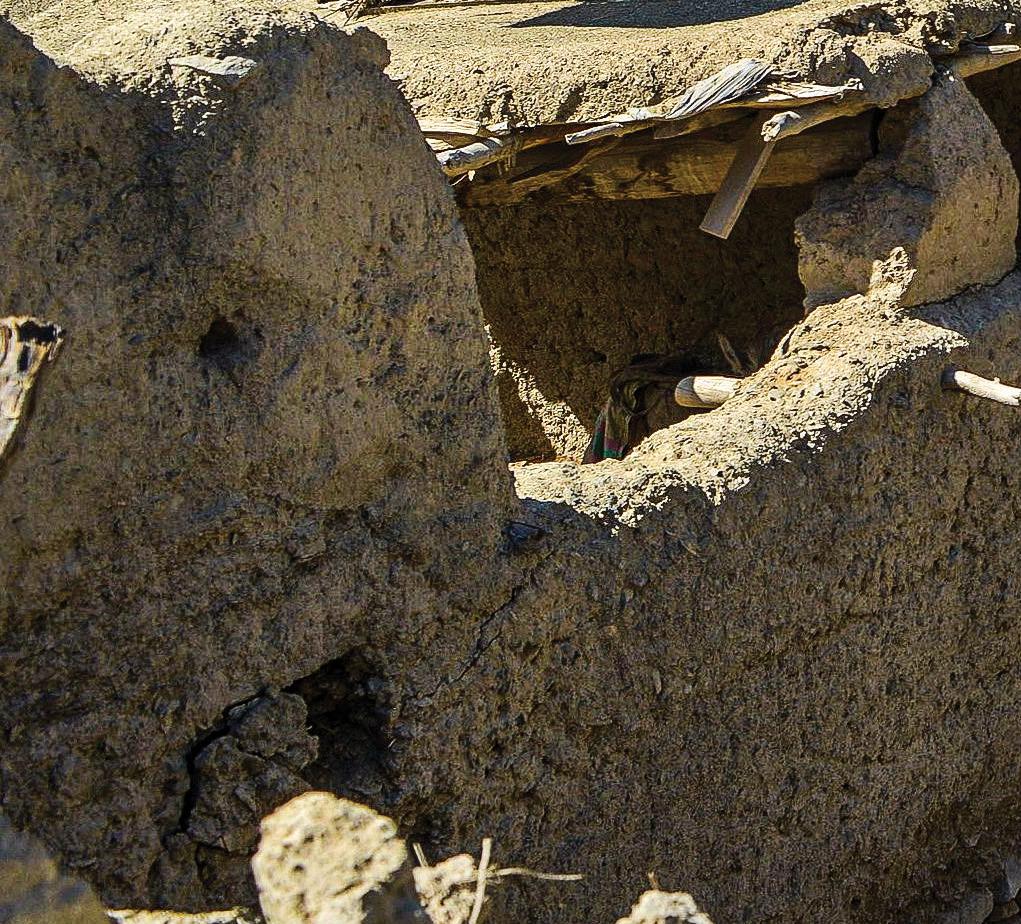


The Brief / Lightbox gulfbusiness.com24 July 2022





gulfbusiness.com July 2022 25
PHOTO: AHMAD SAHEL ARMAN/AFP VIA GETTY IMAGES
WE







CONTENT
BRING
TO LIFE | +971 4 427 3040motivatecreate.com
NEW BRANDING SOLUTION LAUNCHES IN THE REGION
MOTIVATE
Can machinery as trivial as an escalator be leveraged for impact? Or for greater brand recall? With innova tion and intent, most certainly, yes. Global branding solutions provider Motion Icon has introduced an impactful out-of-home (OOH) advertising solution to the region. Engaging its unique and globally patented escalator step branding solution, Motion Icon is empowering companies and brands to leverage previously unavail able retail space to influence and convert their target audiences, just before point of purchase (PoP).
Dubai-headquartered Motivate Media Group, the parent company of titles, including What’s On, Emirates Woman and Gulf Business, is partnering with Motion Icon to introduce the platform to brands across the UAE and Saudi Arabia, spanning shopping malls, airports, exhibition centres, metro stations and other high traffic locations.
The solutions will not only underpin brand ROI and customer conversion, but bolster safety on escalators, enhancing their appearance and by extension, the aesthetic of the property.

Via its production facilities in South Africa, the UK, Australia and the UAE,
Motion Icon has produced over 1,400 escalator advertising campaigns to date, with the technology adopted by several civil authorities and government depart ments to drive effective safety solutions.
Ian Fairservice, managing partner of Motivate Media Group, says: “We are delighted to be partnering with Motion Icon to bring this technology to the region. We’re seeing an increase in demand for OOH services in the UAE and we’re keen to explore this market. The partnership will strengthen our

core offering and further defines our footprint in media.”
Brent Bragge, CCO, Motion Icon, adds: “This product itself is uniquely elegant in reimagining a piece of machinery we all know and somewhat take for granted, transforming it into an eye-catching marketing platform. Its simplicity is the source of its impact –this is as much a story about rebirth, as it is about advertising. The partnership with Motivate Media Group is a huge opportunity for Motion Icon. Motivate brings unrivalled experience and credibility to the product, and their reach throughout the region ensures that brands are able to roll out impactful campaigns with a singular efficiency.”
Christopher Trimble, COO, Motion Icon, comments: “We are revolution ising the OOH advertising industry, having pioneered the development of our globally-patented ‘Escalator Step Brand ing Technology’.
“For the first time, brand owners now have the opportunity to utilise a previ ously unavailable retail space to attract, influence and convert their target market, right before the PoP. Our exclusive sales partnership with Motivate Media Group will create a host of opportunities for brands and property owners, and we could not have wished to be associated with a more reputable, innovative and professional organisation with such a proud history in the media industry.
“Our collaboration has brought immense credibility to our product and we are excited about building the future together.”
FEATURES / ADVERTISING gulfbusiness.com July 2022 27
MEDIA GROUP IS PARTNERING WITH GLOBAL FIRM, MOTION ICON, TO INTRODUCE AN OUTOF-HOME ADVERTISING SOLUTION TO THE REGION
From left to right: David Fairservice , Christopher Trimble, Ian Fairservice and Brent Bragge












gulfbusiness.com WHERE CLASSIC... COVER STORY OPPO














...MEETS CONTEMPORARY OPPO HAS ENABLED CUTTING-EDGE IMAGING TECHNOLOGY IN ITS FIND X5 SERIES, THANKS TO ITS STRATEGIC COLLABORATION WITH VETERAN CAMERA MANUFACTURER HASSELBLAD WORDS: DIVSHA BHAT
The Lunar Module Eagle spacecra t touched down on the Moon in 1962, marking the historic occasion of humans first landing on the Earth’s satellite. NASA’s astronauts on the Apollo 11 mission, Buzz Aldrin and Neil Armstrong, stepped out onto the dusty surface of the Moon, wearing massive space suits. To capture the watershed moment, NASA chose Swedish manufacturer Hasselblad’s cameras, which subsequently immortalised the images of the two heroic astronauts taking a giant leap for mankind.
More than five decades later, NASA’s newest rocket Artemis is all geared up to launch a trip around the Moon this year, an integral task that is inching towards the ultimate mission of transporting people to the Moon in 2026. To commemorate this milestone, OPPO has launched its cutting-edge flagship Find X5 series in partnership with Hasselblad.
“Hasselblad aims to serve image creators who want to be remarkable with their capabilities and inspirations. The collaboration between OPPO and Hasselblad






gulfbusiness.com30 July 2022
Tarek Zaki, senior product manager at OPPO MEA
is focused on developing more advanced imaging solutions, currently starting with so tware improvements aimed at providing users with more natural colours and a more refined imaging experience,” says Tarek Zaki, senior product manager at OPPO MEA.
OPPO has also announced a three-year partnership with the camera manufacturer for the Find series.
The wait is over
OPPO’s latest Find X5 series was unveiled in Dubai Mall at the immersive art experience, Infinity des Lumières, which featured hi-tech digital art masterpieces. In addition to its futuristic aesthetic, the series o ers world-first imaging experiences. Among them is an imaging Neural Processing Unit designed to overcome the most pressing challenge of a smartphone’s video recording – its nighttime recording. With a dual IMX766 camera system, unrivalled performance, ultra-fast 5G connectivity and Supervooc flash charging, this series is said to deliver a truly remarkable experience.
“The Find X5 series is yet another jewel in the crown of OPPO’s innovation and creativity, elevating the series to a whole new level of beauty, redrawing the boundaries of the mobile experience across design, imaging, technology and performance,” states Lucy Aziz, senior PR and communications manager at OPPO GCC.

“It was only fitting to unveil the Find X5 series to stakeholders surrounded by futuristic digital art at Infinity Des Lumières under the guise of their current theme of Destination Cosmos, showcasing the vastness of the universe. This collaboration allows us to honour our strategic partner Hasselblad’s most iconic moment, being the camera used to document the historical first steps of man on the Moon,” she adds.
Futuristic design and display

The OPPO Find X5 Pro features a distinctive design, with the rear camera array resting in an irregularly shaped, elevated section that appears to have been sculpted out of the chassis rather than being fitted into a more standard cut-out.
“The Find X5 series is OPPO’s high-end flagship series. It represents the pinnacle of advanced technology, and provides users with an unmatched design and fantastic product experience,” comments Fadi Abu-Shamat, director of Planning and Strategy at OPPO MEA.
Meanwhile, the ceramic back of the Find X5 Pro has twice the strength of a glass panel and is twice as e ective at dissipating heat. Display-wise, it promises a 6.7-inch ultra-clear curved AMOLED screen. Furthermore, with a 100 per cent P3 colour gamut coverage, the Find X5 Pro’s 10-bit screen displays more than one billion colours, resulting in seamless tonal and colour gradations. With its first multi-brightness colour calibration, the phone provides consistent colours, regardless of whether the user is looking at the screen in dim artificial light or in bright daylight.
Since excessive amounts of specific types of light can disrupt sleep and cause eye fatigue, OPPO has created an 8192-level screen dimming feature in the smartphone so that pupil adjustment speeds can be matched across various lighting conditions.
Empowering every moment
OPPO aims to empower every moment, just as NASA aims to empower more discoveries. The brand seeks to provide consumers with the best technology and user experience which is why it has worked closely with Hasselblad’s engineers to bring natural colour calibration to Find X5 Pro. The natural colour calibration brings iconic natural colour, professional colour profile and style to mobile photography.
OPPO
gulfbusiness.com July 2022 31
The Find X5 series is yet another jewel in the crown of OPPO’s innovation and creativity, elevating the series to a whole new level of beauty, redrawing the boundaries of the mobile experience across design, imaging, technology and performance”
Lucy Aziz, senior PR and communications manager at OPPO GCC
COVER STORY
WITH A 100 PER CENT P3 COLOUR GAMUT COVERAGE, THE FIND X5 PRO’S 10-BIT SCREEN DISPLAYS MORE THAN ONE BILLION COLOURS
COVER STORY
OPPO
“OPPO collaborated with top-tier Hasselblad photographers to jointly develop three creative master-style filters, including Radiance, Emer ald and Serenity that allows users to easily replicate Hasselblad’s masters’ style with their mobile phones,” opines Zaki.
“Image creators are able to use Hasselblad camera to get the uncompromising image quality and true-tonature colour performance. The collaboration between OPPO and Hasselblad is focused on developing more advanced imaging solutions, currently starting with soft ware improvements aimed at providing users with more natural colours and a more refined imaging experience.”
Meanwhile during its research, OPPO also noted how capturing night video poses a significant challenge to users. This makes countless beautiful moments go unre corded or are recorded at low quality. Addressing this
need, OPPO designed a dedicated imaging NPU, MariS ilicon X, to unveil the details at night.

The MariSilicon X is built on a 6nm process and is built for top-tier imaging performance. It has the fastest artificial intelligence (AI) computing power as well as an advanced AI noise reduction algorithm developed by the OPPO Research Institute. As a result, it can reduce noise pixel by pixel in every frame while preserving finer details, skin tones, and colour accuracy.
This further results in a four-fold increase in perceived night video resolution, less grain, and better colour repro duction, making 4K ultra night video available for the first time on an Android phone, each frame looking like a still photograph.
Distinctive performance
Performance is one of the vital factors for users when choosing a smartphone. The Find X5 Pro sports a Qual comm Snapdragon 8 Gen 1 quad-core processor so that it can handle even the most complex games and applications.
In addition to improved AI capabilities, Qualcomm’s integrated flagship GPU delivers 30 per cent more per formance and 25 per cent greater power efficiency than the previous generation.
Despite its class-leading power, OPPO has doubled its efforts to boost battery life on the Find X5 Pro. The

gulfbusiness.com32 July 2022
Fadi Abu-Shamat, director of Planning and Strategy at OPPO MEA
The Find X5 series is OPPO’s high-end flagship series. It represents the pinnacle of advanced technology, and provides users with an unmatched design and fantastic product experience”
OPPO DESIGNED A DEDICATED IMAGING NPU, MARISILICON X, TO UNVEIL THE DETAILS AT NIGHT
smartphone’s 5000mAh dual-cell battery can charge from close to empty to 50 per cent in only 12 minutes, and a 50W Airvooc can wirelessly charge it to 100 per cent in just 47 minutes.

The Find X5 Pro also includes a Battery Health Engine, which helps extend the battery’s life for longer – up to 1,600 charging cycles, roughly twice the industry standard.



Security ‘first’
Nearly 84 per cent of the global population now owns a smartphone, which has made these devices a favoured target for malicious hackers. OPPO has always placed a high priority on the security and safety of its products.
The brand’s human-centric interface, ColorOS 12.1, combined with Google’s Android 12 operating system, delivers incredible experiences and maximum privacy features while maintaining full access to the Google Play Store and over three million applications.
Maintaining the privacy and security of users’ data –whether personal or for business is a top priority and a key focus for ColorOS. These e orts have been recognised by third-party organisations, including ISO, ePrivacy and TrustArc.
Creating new possibilities
OPPO has always strived to meet the core needs of its users and provide optimum customer service. “We have always been committed to technology and product innovation that creates a more comprehensive and immersive user experience. Innovative technologies and unique designs are OPPO’s core competency. We strive to create products that enable users to enjoy the ‘beauty of technology’ by packing the powerful technology into beautiful designs, allowing the state-of-art innovation to flow seamlessly into our customers’ lives,” adds Abu-Shamat.
OPPO is looking to change the way people preserve memories, be it in broad daylight or under the stars. The company’s futuristic endeavour attempts to mirror how half a century ago NASA managed to revolutionise space travel.

gulfbusiness.com July 2022
THE SMARTPHONE’S 5000MAH DUALCELL BATTERY CAN CHARGE IT FROM CLOSE TO EMPTY TO 50 PER CENT IN ONLY 12 MINUTES
Driven by sustainability and innovation




Why should sustainability be considered by tech companies and how are you incorporating it within your ecosystem?

Tell us about the highlights of the Autodesk FY22 Impact report.
The Impact Report outlines our approach and performance within the business



across important environmental, social and governance issues.
Notably, we have neutralised greenhouse gas (GHG) emissions across our operations and entire value chain for the second year in a row. We believe we have the power to create real, meaningful impact and accelerate industry transformation. In October 2021, we issued our first sustainability bond offering, totalling $1bn, to further align our financial and impact strategies. In this year alone, Autodesk has reduced 1.4 million+ metric tons CO2 of GHG through the Autodesk Foundation’s global portfolio and $18.5m was raised in philanthropic funding by Autodesk and the Autodesk Foundation. We’re proud of the progress that has been made, but much work remains to be done, and we have multiple levers in place to drive progress across the business and that of our clients and the wider industry.
Each year, we see a rise in demand for more and cleaner resources as the global population and standards of living continue to increase. We envision a lowcarbon future with minimal pollution and waste, where renewable energy powers our world and materials maintain value while cycling through a circular economy. We remain steadfast in our commitment to advance sustainable business practices toward net-zero carbon emissions, both here in the region in line with the UAE net zero goals, as well as globally.
Technology, deployed appropriately, has the power to solve the most challenging global issues, measure, manage and reduce greenhouse gas (GHG) emissions, and improve global health and resilience.
Our technologies create a positive impact across industries, by empowering
AUTODESK HAS REDUCED 1.4 MILLION+ METRIC TONS CO2 OF GHG EMISSIONS THROUGH THE AUTODESK FOUNDATION’S GLOBAL PORTFOLIO
 Louay Dahmash
Louay Dahmash
Louay Dahmash, senior director at Autodesk, talks about the company’s vision to create real, meaningful impact with its technology and accelerate industry transformation
customers to harness data, automation, and insights to improve the impact of design and make decisions, enabling them to reduce costs and energy.
Is there specific legislation that compels companies to declare their carbon production to achieve sustainability goals?
Approximately 19 per cent of global GHG emissions are from the manufacturing industry. In addition to that, the buildings sector represents 38 per cent of energy and process-related GHG emissions globally. Legislations can therefore, provide a framework to regulate the path to sustainability.
For example, in order to comply with materials regulations worldwide, such as the European Union’s legislation, and the UAE’s National Climate Change Plan of the UAE 2017–2050, which sets a clear path to reducing emissions, companies face increasing pressure to assess and document the materials used in their products, and in some cases to ensure materials’ traceability throughout the supply chain.
We work with our customers to better manage and measure their impact through advanced data and analytics and enable them to reduce embodied carbon, decrease construction waste, and develop smart and sustainable cities.
What are the challenges that you’ve faced when making your business model more sustainable?
There are specific technology related challenges to achieving the above goals as
firms worldwide grapple with digital transformation. Supporting our customers with critical technology is therefore an important opportunity area for us. In addition, the accelerated pace of change today demands that we work beyond industries to drive cross-sector collaboration and catalyse industry-wide innovation. It is also imperative to upskill our employees for the challenges of Industry 4.0 to ensure a resilient and prosperous future. We prioritise the health, wellbeing, and safety of our employees, who advance our efforts in this area. They create and deliver the practices and technologies that our customers and other innovators can use to design and make products and places that are safer, healthier and more resilient.
Finally, for business models to be truly sustainable it is important for the entire value chain to be sustainable. The focus should be on creating a truly sustainable business with efficient operations committed to net-zero carbon and 100 per cent renewable energy commitments alongside a prosperous workforce to enable a sustainable future for all.
How are you helping customers drastically reduce their own environmental footprint?
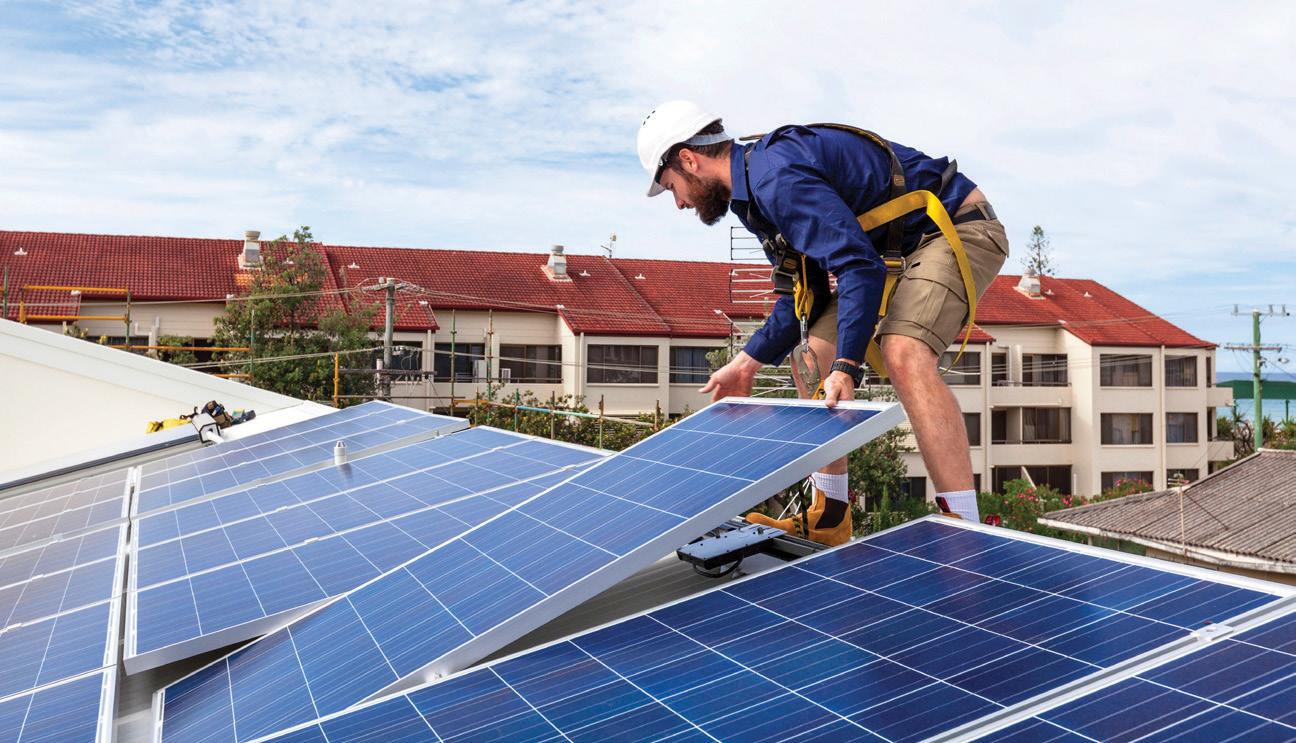
Our customers represent our largest opportunity to create a positive impact at scale. Our software platform helps automate complex processes and transform data into actionable insights that empower innovators to improve the impact of everything they design, make, own and operate. Cloud solutions and connected data environments fuel innovation – across technology, processes, supply chain and industries. Through our technology, we are empowering them to create solutions, connect their data, and accelerate the outcomes that matter to them.
How does sustainability affect society and the future of work?
It is important to address workforce prosperity and the needs and desires of multiple stakeholders, from employees to customers to communities as well as investors. As more and more stakeholders become involved in business decisionmaking, it’s driving the movement toward more sustainable future operations.
Governments can also support stakeholder capitalism with initiatives that protect consumer data and the environment and promote investment in employees.
The UAE is an ideal platform to advance our future skilling initiatives as we align with the goals of the visionary leadership of instilling digital education and skills into the youth, and providing an array of opportunities for them to access lifelong learning which will empower them to become the change makers of tomorrow.
The global economy is changing, and the workforce of tomorrow won’t look the same as today. While new technologies can enable great efficiency, we believe the future of work is still human.
Our technologies create a positive impact across industries, by empowering customers to harness data, automation, and insights to improve the impact of design and make decisions, enabling them to reduce costs and energy”
BRAND VIEW
HANDING DOWN A LEGACY

WE LOOK AT HOW FAMILY BUSINESSES HAVE PLAYED A COHESIVE ROLE WITHIN THE WIDER ECONOMIC LANDSCAPE



Enterprising. Resilient. Expansive. Perhaps the most apt qualifiers that spring to mind when one considers family businesses and their role within the wider economic landscape. Strategic, committed to long-term visions and operating on strong fundamentals are some of the many reasons why family businesses have proved resilient time and again.
According to the 2021 EY and University of St. Gallen Family Business Index, the world’s largest 500 family businesses collectively generated $7.28tn in revenue and employed 24.1 million people. The EMEIA (Europe, Middle East, India and Africa) region was home to 52 per cent of those companies in the index, of which three were headquartered in the UAE.








The UAE and the GCC region are no di erent, with family-owned companies not only considered one of the















FEATURES / FAMILY BUSINESSES gulfbusiness.com36 July 2022
ZAINAB MANSOOR
JUST LIKE GOVERNMENTS ACROSS THE REGION HAVE RESPONDED TO ECONOMIC, SOCIAL, TECHNOLOGICAL AND DEMOGRAPHIC CHANGES, WHILST AT THE SAME TIME BEING TRUE TO THEIR HERITAGE AND TRADITIONS"
John Iossifidis
WORDS: ZAINAB MANSOOR
most trusted forms of business, but also credited as major drivers of job creation and inclusivity. “Family businesses have long played an important role in the development of the economies across the Gulf region. Just like governments, family businesses across the region have responded to economic, social, technological and demographic changes, whilst at the same time being true to their heritage and traditions,” says John Iossifidis, group CEO of Al Ghurair Investment, a Dubai-headquartered family business group with operations in sectors such as food, resources, properties, construction, energy, mobility and ventures.
Adopting change

Customers and markets have evolved over time – a trend that has prompted change across companies and is also propelling family-owned enterprises to strive and transition towards a technology-driven, sustainable future. Family businesses in the Middle East hold clear priorities for the imminent future and five themes have emerged, according to PwC’s Middle East Family Business Survey 2021. These include diversification, transformation, family values, resilience and impact.
Expanding into new markets/client segments is a top priority for 58 per cent of Middle East family businesses over the next two years, the PwC survey revealed. Meanwhile, increasing use of



new technologies and improving digital capabilities are top priorities for 55 per cent and 47 per cent of such businesses over the next two years, respectively.

Leveraging technologies and digital solutions, family businesses are ready to embrace change to up their game. “To remain viable, businesses must continually grow and adapt to current times. As traditional boundaries are being disrupted due to tech innovation, the digital age presents opportunities for retailers like us to bring in greater levels of operational e ciency and customer centricity in their business models – especially when it comes to the customer experience,” notes Mohammad Badri, director of Eros Group, a UAE-based organisation specialising in the distribution and retail of consumer electronics, mobility, IT, home appliance and convergence products. “It has helped us build delivery capabilities such as buy online, and develop support and payment competencies through automated customer service, digital payment service, etc.”
Iossifidis adds: “Digitalisation and the use of data is an integral part of our transformation journey – be it promoting fully digital workflows, further investing in technology to optimise business operations or the use of data to enable our people to make better decisions. We aim to continue looking for ways to integrate modern applications within our organisational capabilities.”
Keeping order

While harnessing innovative technologies to underpin operational capabilities is paramount, sound corporate governance is also key to business continuity and growth, the absence of which can pose several challenges. Governance is equally important for family businesses to foster harmony and help drive the company in a seamless fashion. Institutionalising clear policies and frameworks enables e ective management and helps achieve objectives.
Iossifidis says, “In 2020, we embarked on a strategic transformation journey that places high importance in augmenting Al Ghurair’s governance and corporate structure. With the breadth of our business, we recognise the need to build governance structures to ensure strategic execution and good management. As the region also undergoes a dramatic economic transformation, family businesses need to be agile – to be able to capture opportunities arising from such changes. We strive to be on top of emerging ESG (environment, social and governance) trends, especially because we are also one of the biggest employers in the region, with around 28,000 employees."
Meanwhile, e ective succession planning ensures companies earmark new leaders to run point in terms of natural progression and also in the event of unforeseen challenges. Earlier this year, a new law was issued to regulate family business ownership in Abu Dhabi. The law, which aimed to facilitate smooth transition of businesses between generations, empowered owners of family businesses to prevent the selling of shares or dividends outside the family; to require prior approval from family partners before a shareholder could sell his/her equity stake to a non-family member; and to issue family-owned shares with weighted voting rights. However, the directive is not applicable to family-owned businesses where
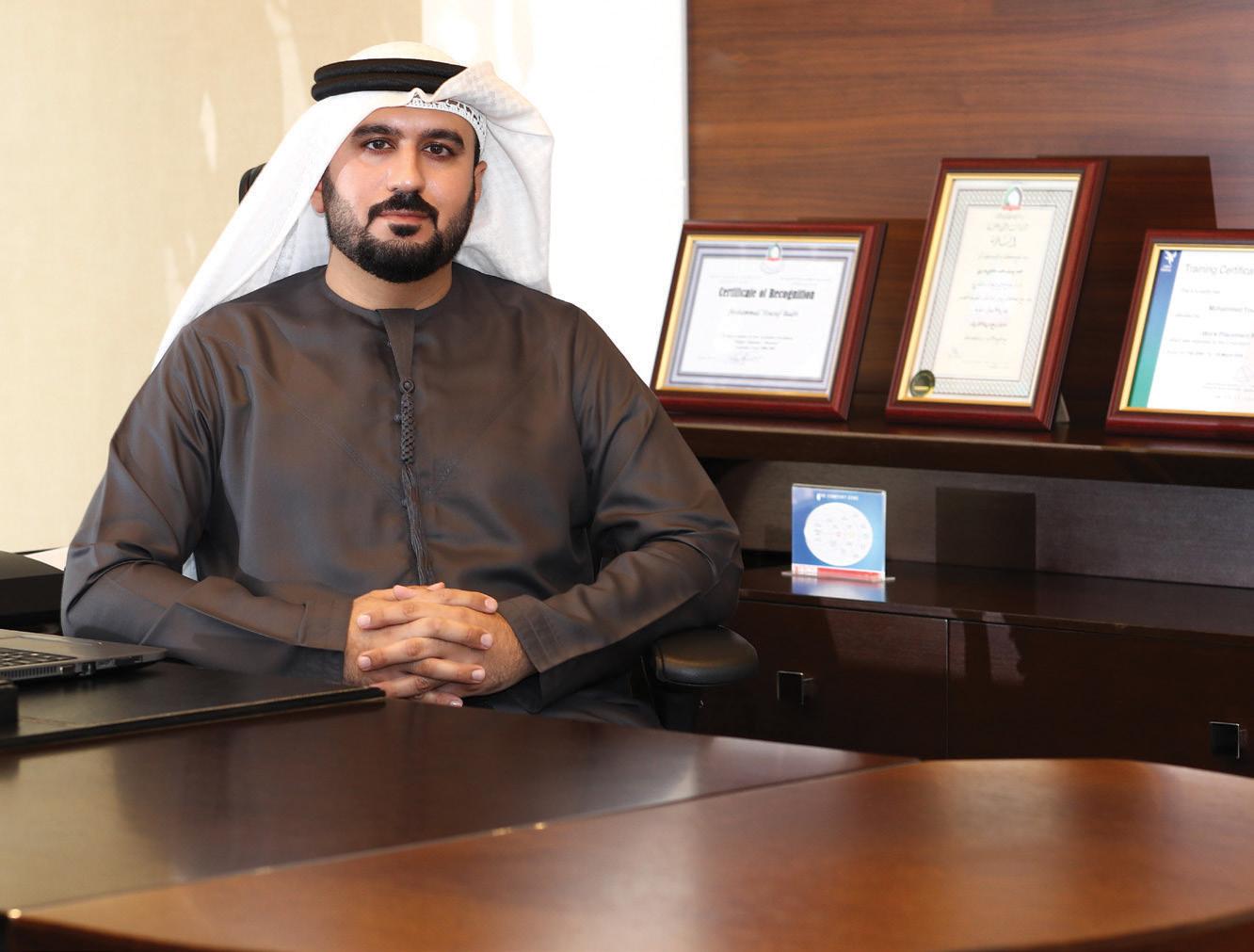
FEATURES / FAMILY BUSINESSES gulfbusiness.com July 2022 37
EXPANDING INTO NEW MARKETS/CLIENT SEGMENTS IS A TOP PRIORITY FOR 58 % OF MIDDLE EAST FAMILY BUSINESSES
Mohammad Badri
AS TRADITIONAL BOUNDARIES ARE BEING DISRUPTED DUE TO TECH INNOVATION, THE DIGITAL AGE PRESENTS OPPORTUNITIES FOR RETAILERS LIKE US TO BRING IN GREATER LEVELS OF OPERATIONAL EFFICIENCY AND CUSTOMER CENTRICITY IN THEIR BUSINESS MODELS"
non-family members own more than 40 per cent of shares.
“Succession in a family business is perhaps the most critical challenge. Also, when many family-owned businesses are passed on to the next-generation heirs, there is a sense of entitlement,” adds Badri. “My father, Yousuf Badri, is a visionary man who had a clear direction for the company and Eros continues this vision, which is to bring value to all our stakeholders. Eros Group is managed by my brother (Ahmad Badri) and I since early 2012. As next-generation successors, we initially worked at different companies before joining the family business, which helped in bringing a new set of capabilities, experience, and fresh thinking.”
Many Middle East family businesses are reaching a critical stage of succession, the PwC survey noted – with second gen eration family members already majority shareholders in 56 per cent of businesses. Adel Sajan, managing director of Danube Group, a UAE-based conglomerate with interests in building materials, home décor and real estate development –opines that the second generation of the family is now closely working under the leadership of the first generation. “My father, Rizwan Sajan, the chairman and founder of Danube Group, started the business in 1993 along with my mother who supported him. I belong to the second generation. Then my uncle, Anis Sajan, joined the business and developed a new arm – Milano. Gradually, they’ve both led the business to wherever it is today.”
He adds: “We have a clear-cut business strategy for the family-owned business – growing with the family. Each new member develops a new branch of the business and takes it to the next level. This way, we all contribute to the group and the individual brands and divisions.”
In May this year, Easa Saleh Al Gurg Group, the Dubai-based family busi ness, confirmed the appointment of Dr Raja Easa Al Gurg as its new chairper son, succeeding her father who passed away in March. The company said the appointment, which is in-line with the group’s pre-approved succession plan ning charter, ensured a smooth business transition. “Succeeding my late father is a tremendous privilege and one that I take up with great responsibility. I look forward to continuing on the path of his forward thinking strategies for the Group as he was a true visionary,” says Dr Al Gurg.

Long haul
Dynamic market conditions, macroe conomic factors and unforeseen events – such as the global health crisis from which the world continues to heal –are likely to pose challenges, which
businesses, including family-owned ones, must overcome to stay in the reckoning.
“Family businesses need to innovate in order to remain relevant to our vari ous stakeholder groups – whether it be about implementing technology-enabled business processes, adapting to new ways of working or embracing ESG practices,” adds Iossifidis.
Meanwhile, Danube Group’s Azhar Sajan, who is director of Casa Milano, says: “Most of the challenges in a familyowned business come from the external front – especially when there is a slow down in economic activities or a Covid-19 pandemic-like situation. However, if one remains focused, then facing challenges becomes easy, especially if you can assess the situation correctly.”
Family businesses have stood the test of time and judging by precedent, will continue to be the bastion of economic progress in years to come.
FEATURES / FAMILY BUSINESSES gulfbusiness.com38 July 2022
WE HAVE A CLEAR-CUT BUSINESS STRATEGY FOR THE FAMILY-OWNED BUSINESS –GROWING WITH THE FAMILY. EACH NEW MEMBER DEVELOPS A NEW BRANCH OF THE BUSINESS AND TAKES IT TO THE NEXT LEVEL. THIS WAY, WE ALL CONTRIBUTE TO THE GROUP AND THE INDIVIDUAL BRANDS AND DIVISIONS”
THE WORLD’S LARGEST 500 FAMILY BUSINESSES COLLECTIVELY GENERATED IN REVENUE AND EMPLOYED 24.1 MILLION PEOPLE $7.28tn
Sahil, Adel, Azhar and Sana Sajan
A HANDY GUIDE TO DUBAI’S OFFICIAL RESIDENTIAL REAL ESTATE PERFORMANCE INDEX
Mo’asher: Sales
MARCH TO MAY THIS YEAR
KEY FINDINGS
• In May, 6,652 sales transactions worth Dhs18.4bn were recorded
• May’s highlights included a 1.296 monthly index for sales and an index price of Dhs1,261,379. The apartments monthly index recorded 1.368 and an index price of Dhs1,175,363. The villas/townhouses monthly index recorded 1.338 and an index price of Dhs2,150,469
MAY’S SALES TRANSACTION VOLUME INCREASED BY 51.60%
AND THE VALUE INCREASED BY 66.14% YEAR-ON-YEAR
THE
FOR THE
OF
POWERED BY PROPERTY FINDER
DUBAI APARTMENTS INDEX
DUBAI OVERALL INDEX
VILLAS/TOWNHOUSES INDEX
gulfbusiness.com July 2022 39 SOURCE: PROPRIETARY PROPERTY FINDER DEMAND DATA, JANUARY 2021 TO MAY 2022
DUBAI
Apr 2022 May 2022 Mar 2022 Oct 2021 May 2021 Feb 2022 Sep 2021 Apr 2021 Jan 2022 Aug 2021 Mar 2021 Dec 2021 Jul 2021 Feb 2021 Nov 2021 Jun 2021 Dec 2020 Mar 2022 Oct 2021 May 2021 Feb 2022 Sep 2021 Apr 2021 Jan 2022 Aug 2021 Mar 2021 Dec 2021 Jul 2021 Feb 2021 Nov 2021 Jun 2021 Jan 2021 Dec 2020 Apr 2022 May 2022 Index value Dhs1,871,675 Index value Dhs2,150,469 Index value Dhs2,003,451 Index value Dhs1,024,482 Index value Dhs1,141,665 Index value Dhs1,261,379 Jan 2021 1.4 1.2 1 0.8 0.6 0.4 0.2 0 1.4 1.2 1 0.8 0.6 0.4 0.2 0
INDEX BASE: JANUARY 2012
Index value Dhs1,013,880 Index value Dhs916,322 Index value Dhs1,175,363 Index value Dhs1,026,758 Mar 2022 Oct 2021 May 2021 Feb 2022 Sep 2021 Apr 2021 Jan 2022 Aug 2021 Mar 2021 Dec 2021 Jul 2021 Feb 2021 Nov 2021 Jun 2021 Jan 2021 Dec 2020 Apr 2022 May 2022 1.4 1.2 1 0.8 0.6 0.4 0.2 0 Index value Dhs944,982 Index value Dhs1,711,382
OFFICIAL SALES PRICE INDEX
EMIRATE
DUBAI INDEX NUMBER
In May, Dubai recorded the highest volume of sales transactions for same month in the past decade
THE
- APRIL
JANUARY
KEY FINDINGS
In May, annual contracts made up 80.9 per cent of the total contracts while 19.1 per cent were non-annual
Registered leases for residential purposes comprised 73.8 per cent of the total contracts, while 25.3 percent were registered for commercial purposes
In May, the total number of rental leases increased by 2.1 percent over the same period last year
MAY HAD
DUBAI OVERALL INDEX
DUBAI APARTMENTS INDEX
DUBAI VILLAS/TOWNHOUSES INDEX
gulfbusiness.com40 July 2022SOURCE: PROPRIETARY PROPERTY FINDER DEMAND DATA, MARCH 2022 TO MAY 2022 DECEMBER 2020 -
2022 INDEX NUMBER
Mar 2022 Oct 2021 May 2021 Feb 2022 Sep 2021 Apr 2021 Jan 2022 Aug 2021 Mar 2021 Dec 2021 Jul 2021 Feb 2021 Nov 2021 Jun 2021 Jan 2021 Dec 2020 Apr 2022 May 2022 JANUARY 2021
2022
Apr 2022 M ay 2022 Mar 2022 Oct 2021 May 2021 Feb 2022 Sep 2021 Apr 2021 Jan 2022 Aug 2021 Mar 2021 Dec 2021 Jul 2021 Feb 2021 Nov 2021 Jun 2021 Jan 2021 Dec 2020 INDEX NUMBER Index value Dhs51,140 Index value Dhs51,184 Index value Dhs52,013 Index value Dhs128,778 Index value Dhs132,401 Index value Dhs131,428 1.4 1.2 1 0.8 0.6 0.4 0.2 0 1.4 1.2 1 0.8 0.6 0.4 0.2 0
•
•
•
35,327 RENTAL LEASES: 59.6% WERE NEW, WHILE 40.4% WERE RENEWALS INDEX BASE: JANUARY 2013
Mar 2022 Oct 2021 May 2021 Feb 2022 Sep 2021 Apr 2021 Jan 2022 Aug 2021 Mar 2021 Dec 2021 Jul 2021 Feb 2021 Nov 2021 Jun 2021 Jan 2021 Dec 2020 Apr 2022 May 2022 Index value Dhs46,888 Index value Dhs47,910 Index value Dhs46,951 1.4 1.2 1 0.8 0.6 0.4 0.2 0 Index value Dhs47,721 Index value Dhs125,944 Index value Dhs51,468 Mo’asher: Rental
OFFICIAL RENTAL PRICE INDEX FOR THE EMIRATE OF DUBAI MARCH TO MAY THIS YEAR INDEX NUMBER POWERED BY PROPERTY FINDER
Best
PROPERTY FINDER
gulfbusiness.com July 2022 41
places to stay The most sought-out areas in Dubai’s residential real estate market, with details about the average sales and rental rates AVERAGE PRICE PER TYPE OF UNIT SALES : APARTMENTS Studio 1 Bed 2 Bed 3 Bed 750* 1.1692* 1.5 3.2 1.2 1.7 5 1.3 1.3 2.4 4.7 31.8 410* 2.6 1.15 3.3 2 DHS MILLIONS * DHS THOUSANDS AVERAGE PRICE PER TYPE OF UNIT RENT: APARTMENTS Studio 1 Bed 2 Bed 3 Bed 75 100 280 185 50 62 160 11490 34 40 50 100 110 70 55 8570 180 125 DHS THOUSANDS Dubai Marina 16.60% Downtown Dubai 12.70% Palm Jumeirah 8.60% Business Bay 7.20% Jumeirah Village Circle 5.20 % Dubai Marina 10.80% Downtown Dubai 7.50% Business Bay 6.90% Jumeirah Village Circle 6.10% Jumeirah Lake Towers 4% March to May 2022 combined March to May 2022 combined SOURCE: PROPRIETARY PROPERTY FINDER DEMAND DATA, MARCH 2022 TO MAY 2022 TOP 5 SEARCHED AREAS AVERAGE PRICE PER TYPE OF UNIT Dubai Hills Estate 9.10% Palm Jumeirah 6.60% Arabian Ranches 2 5.80% Arabian Ranches 5.70% DAMAC Hills (Akoya by DAMAC) 4% 2 Bed 3 Bed 4 Bed 5 Bed SALES: VILLAS/TOWNHOUSES 32.5 16.5 9.5 24 1.8 42.2 5 3.9 4.8 2.11.9 6.3 3.1 6.5 4.7 DHS MILLIONS March to May 2022 combined TOP 5 SEARCHED AREAS TOP 5 SEARCHED AREAS AVERAGE PRICE PER TYPE OF UNIT Dubai Hills Estate 6.80% Jumeirah 6.10% Al Barsha 4.50% Arabian Ranches 4.40% The Springs 4.30% 2 Bed 3 Bed 4 Bed 5 Bed RENT: VILLAS/TOWNHOUSES DHS THOUSANDS 280 325 380263 300 300250235205 210 180145 155 165 200 10090 95 March to May 2022 combined TOP 5 SEARCHED AREAS 120 POWERED BY
Strong performance
The areas in Dubai that recorded the largest number of residental sales transactions in the last three months (March, April and May)
APARTMENTS
OFF-PLAN
Business Bay 1,404 Downtown 932
Mohammed Bin Rashid City 775
Dubai Creek Harbour (The Lagoons) 757
Jumeirah Village Circle 604 Dubai Marina 425 Arjan 286 Dubai Harbour 265 Jumeirah 225 Al Wasl (Dubai Water Canal) 160

VILLAS/TOWNHOUSES


OFF-PLAN
Arabian Ranches 3
Dubai South (Dubai World Central)
Villanova
The Valley
Rukan
Town Square
Dubai Investments Park
Al Barari
Tilal Al Ghaf
Dubai Hills Estate
SECONDARY SECONDARY
Dubai Marina 721 Business Bay 692
Jumeirah Village Circle 645 Downtown 612 Palm Jumeirah 503
International City 407
Jumeirah Lake Towers 373
Jumeirah Beach Residence 294
Dubai Sports City 236 Dubai Hills Estate 230
Damac Hills 2 (Akoya)
Dubai Hills Estate
Arabian Ranches 2
The Springs
Villanova
Arabian Ranches

Furjan
Reem
Town Square
YTD
May’22)
gulfbusiness.com42 July 2022
2022
(until
361
339
185
167
118
99
71
64
63
26
212
121
112
92
90
86 Al
65
62 Mudon 58
56
SOURCE: DUBAI LAND DEPARTMENT 20,013 transactions SECONDARY OFF-PLAN 14,113 transactions MORTGAGE VALUE Dhs42,365,430,782 SALES VALUE Dhs91,908,670,577 MORTGAGESALES March to May 2022 May 2022 18 transactions OFF-PLAN 7,549 transactions SECONDARY SALES VALUE Dhs59,017,068,705 Total sales volume 22,010 Sales volume O -plan 8,866 Secondary 13,144 SALES VALUE Dhs18,360,576,826 Total sales volume 6,652 Sales volume O -plan 2,757 Secondary 3,895 SOURCE: DLD TRANSACTIONS REGISTRY MORTGAGE VALUE Dhs30,434,192,044 Total mortgage volume 4,476 Mortgage volume O -plan 11 Secondary 4,465 MORTGAGE VALUE Dhs8,497,812,793 Total mortgage volume 1,306 Mortgage volume O -plan 3 Secondary 1,303 POWERED BY PROPERTY FINDER
LOGISTICS AND SUPPLY CHAIN
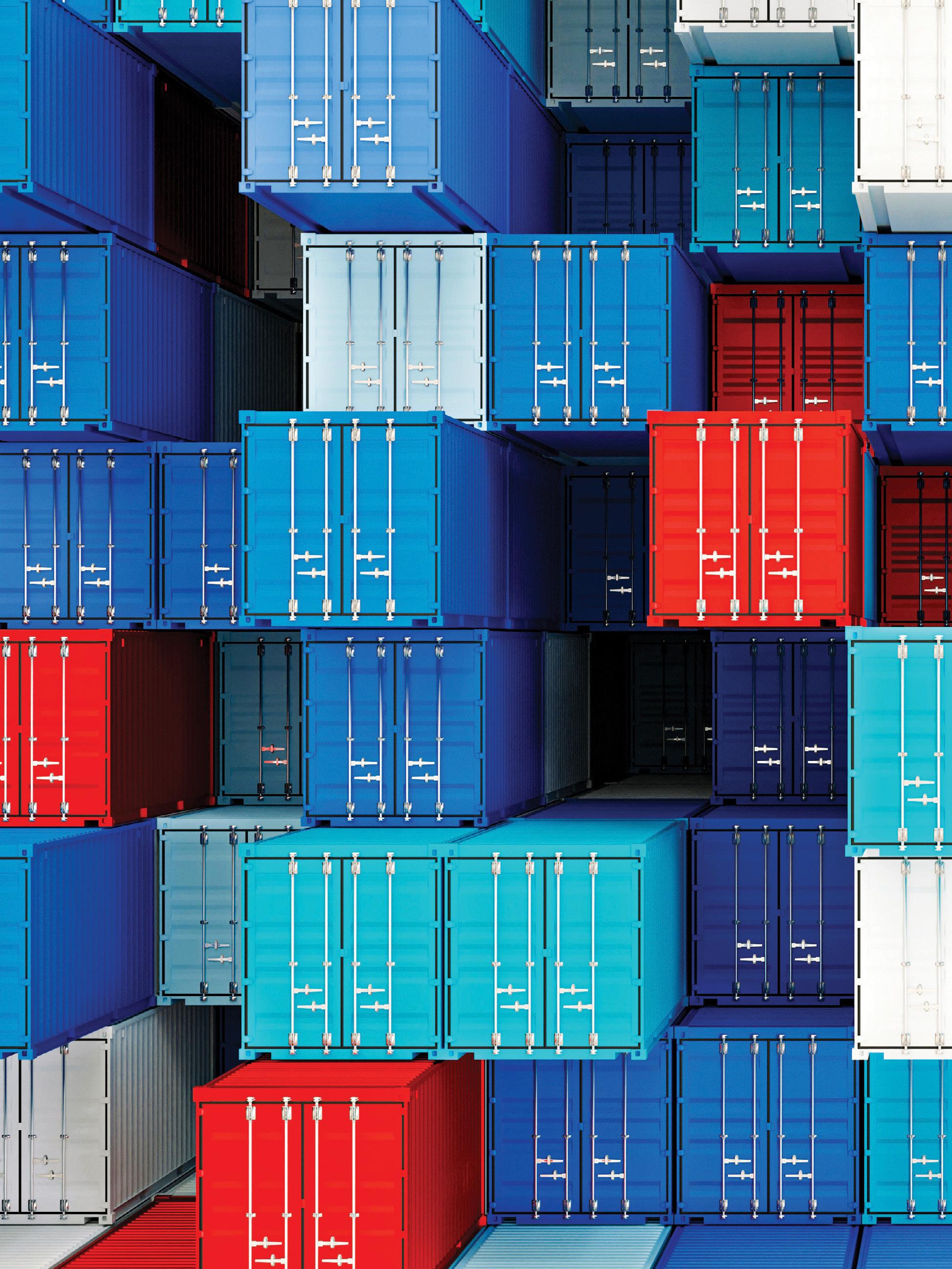
SPECIAL REPORT
Destination : SUSTAINABILITY
LOGISTICS COMPANIES ARE INCREASINGLY WORKING TOWARDS ADOPTING SUSTAINABLE PRACTICES, FROM REDUCING THE OVERALL AMOUNT OF PACKAGING USED, TO ENHANCED DELIVERY SCHEDULES THAT CAN BE FULFILLED IN LESSER TRIPS
WORDS: NEESHA SALIAN
Withbusinesses being increasingly urged to reduce their carbon emissions and adopt
more sustainable business models, the logistics and transportation industry is under tremendous pressure to follow suit, and for good reason.
According to the Sustainable Freight Buyers Alliance (SBFA), freight transport accounts for 8 per cent of global CO2 emissions. By 2050, direct CO2 emissions from the logistics sector is set to rise by 42 per cent. The alliance, a bridge between freight buyers and freight decarbonisation initiatives to support the industry’s transition to net-zero freight
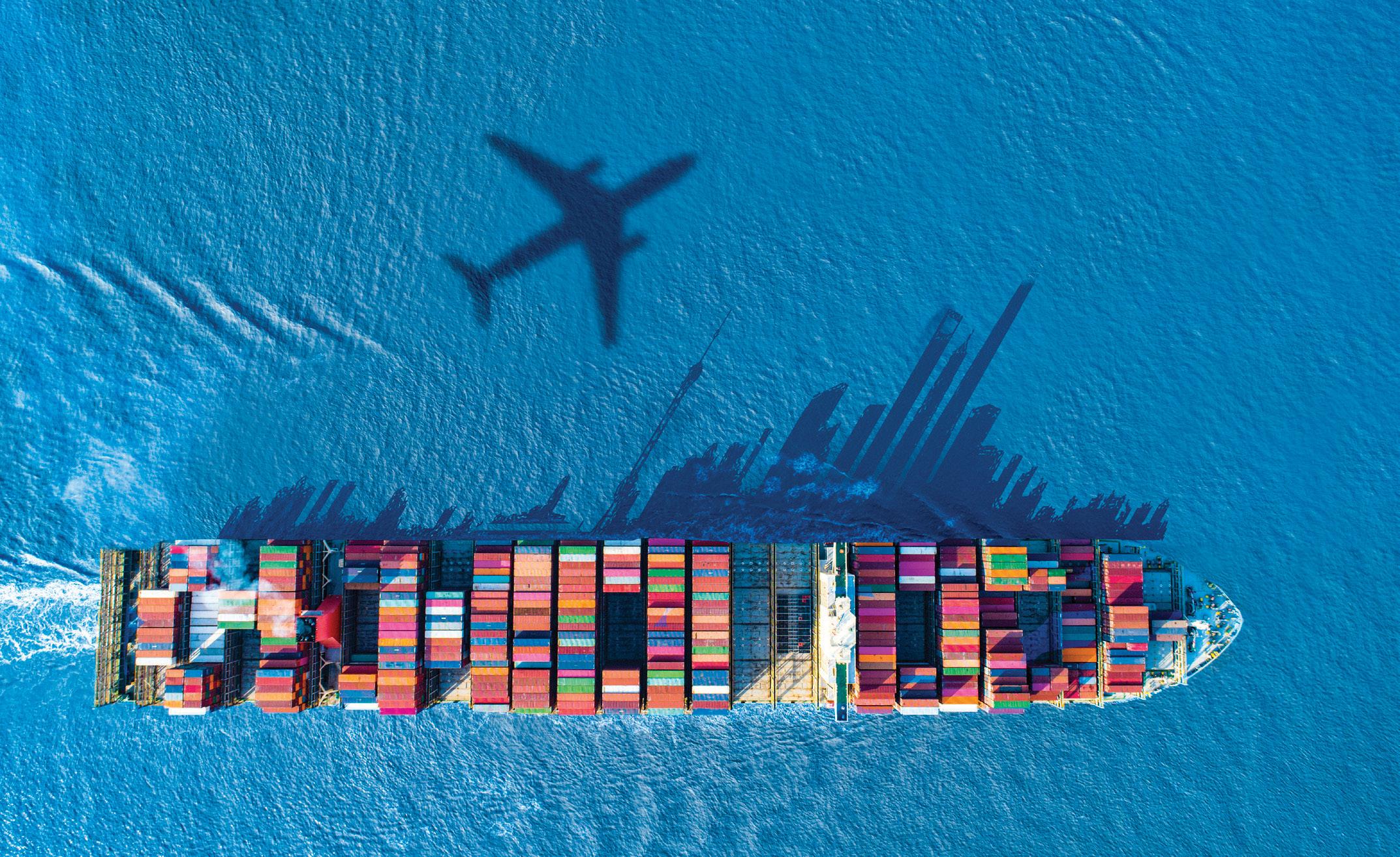
transport, states that decarbonising freight transport is critical to achieving the global goals of net-zero greenhouse gas emissions by 2050.
Is that a tall order? Dr Shereen Nassar, Global Director of Logistics Studies, Edinburgh Business School, Heriot-Watt University Dubai, says decarbonisation targets can only be addressed when companies relook at their traditional working methods. “Logistics and transport sustainability goals need to

Special Report / Decarbonisation
gulfbusiness.com44 July 2022
Dr Shereen Nassar
be developed and integrated within the business model and strategy to ensure accountability and compliance with environmental, social and economic requirements by all the stakeholders, including governments, non-government organisations (NGOs), citizens, investors, customers and companies themselves.”
Transparency is critical when it comes to reporting emissions, which is mandatory in certain countries. Bodies such as the Global Logistics Emissions Council (GLEC), an industryled partnership is driving emission reduction across global logistics supply chains through global guidelines for reporting and reducing logistics emissions that work for business.
The council is led by the Smart Freight Centre, an international non-profit organisation focused on reducing greenhouse gas emission from freight transportation. The centre and the World Business Council for Sustainable Development recently reiterated their commitment to increase transparency on carbon emissions and work towards a net-zero logistics sector. Supported by the World Economic Forum, with McKinsey & Company providing analytical insights and advisory guidance, and in partnership with over 25 global organisations, this consortium is taking the next steps in achieving net-zero logistics by co-developing an actionable and implementable framework to quantify the impact of GHG (greenhouse gas) logistics emissions from the supplier to the final customer; from end-to-end.
The adoption of sustainable practices across the sector is gaining momentum. Dr Nassar says that logistics companies are increasingly working towards it, from reducing the overall amount of packaging used, to enhanced delivery schedules that can be fulfilled in lesser trips.
“Retailers are now becoming more conscious of the kind of logistics service providers they use. As a result, electric, hybrid and low carbon emission vehicles are becoming increasingly important in the logistics fleet. In addition, reusing and recycling are integral to a sustainable supply chain. As a step further toward sustainability, initiatives are growing for the transformation from a linear supply chain toward a closed-loop and circular supply chain model that are key to sustainability. This model requires close partnership with supply chain partners to establish sustainable practices throughout the supply chain to support a circular plan for the full lifecycle of a product and its packaging,” adds Dr Nassar.
Challenges still exist

Despite the willingness to go carbon neutral and achieve net-zero targets, there are hurdles. The Covid-19 pandemic led to a rise in e-commerce; and while customers want sustainable products, they want them immediately and, at reasonable prices. This means more deliveries, tra c congestion and even more emissions.







According to a study by the World Economic Forum, by 2030, last-mile delivery emissions are set to increase by more than 30 per cent in 100 cities globally. Additionally, these commutes could increase by 21 per cent, taking up to 11 minutes longer due to the extra tra c on the road. And while companies are taking to using electric delivery vehicles, it’s

Special Report / Decarbonisation
gulfbusiness.com July 2022 45
Retailers are now becoming more conscious of the kind of logistics service providers they use. As a result, electric, hybrid and low carbon emission vehicles are becoming increasingly important in the logistics fleet”
expensive to replace traditional commercial vehicles with hybrid or electric vehicles (EVs) to add to the possibility of inadequate infrastructure to supporting electric vehicles. Low emission modes of transport such as rail could also mean longer lead times and higher costs.
Companies that use carbon o sets (a way to compensate for your emissions by funding an equivalent carbon dioxide saving elsewhere) to meet decarbonisation targets are being scrutinised for a host of reasons such as the quality and price of the o sets.
These issues may dampen the resolve of logistics providers to go carbon neutral immediately, but as EVs become more mainstream and hydrogen powered vehicles join the ecosystem, the pressure will ease. Plus, solutions such as night delivery and pick-up and drop-o centres, will also yield benefits.

Taking the lead
Setting good examples are the early adopters of decarbonisation, which include logistics companies, such as Maersk, which have made sustainability a strategic goal.
Maersk has committed to setting targets as laid down in the Science-Based Targets initiative (SBTi), a global coalition established in 2015, which aims to enable companies to set emission reduction targets in line with leading climate science.
Christopher Cook, managing director, Maersk UAE, Qatar and Oman, says, “We have taken 2020 as the baseline year, and set near-term targets for 2030 and a net-zero target for 2040. This means that by 2040, we want to achieve net-zero across our business and 100 per cent green solutions for our customers. Initiatives have also been launched to achieve these targets. In fact, our first vessel to run on green fuel will be operational in 2023 – seven years ahead of the initial commitment of 2030. We have

ordered 12 larger container vessels with a capacity of 16,000 TEUs (twenty feet equivalent units) that will run on green methanol. Delivery starts in 2024.
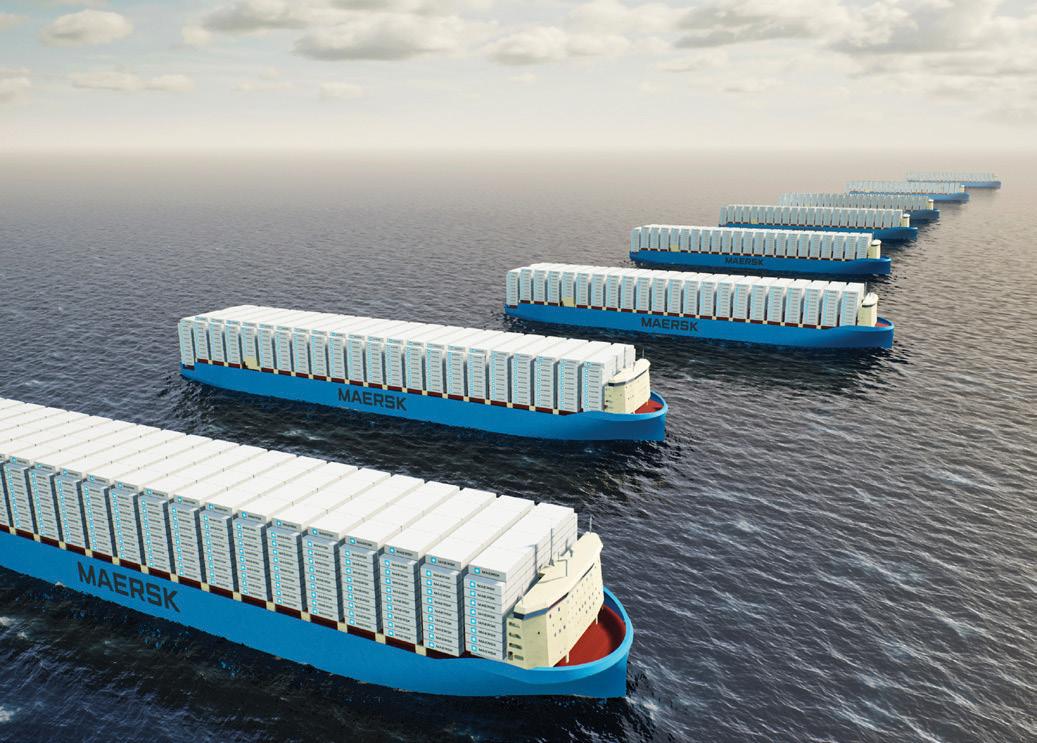
“We are also tying up with several companies and countries to source the right fuel for these vessels, as that will be the biggest challenge in the coming years. We believe getting to decarbonised logistics is the right thing to do, and we must act upon it now. Even our customers expect us to support them in decarbonising their supply chains, and our vision matches our customers in that sense.”
Scandinavian company Scan Global Logistics is also using sustainable fuel to enhance its air freight operations. Mads Drejer, the company’s global chief operations o cer and chief commercial o cer, says, “We have recently invested heavily in sustainable aviation fuel (SAF) and are now in a position to o er it to our customers globally. This fuel has the potential
We believe getting to decarbonised logistics is the right thing to do, and we must act upon it now. Even our customers expect us to support them in decarbonising their supply chains, and our vision matches our customers in that sense”
Special Report / Decarbonisation gulfbusiness.com46 July 2022
Christopher Cook
Special Report / Decarbonisation
80%
The company has made investments towards the deploy ment of solar panels and the introduction of electric vehicles to its fleet. “In addition, we have made the switch to innova tive and reusable packaging to reduce plastic pollution and its negative impact on the physical environment and wild life,” said Saoudi.
to reduce carbon emissions by up to 80 per cent.”
The company’s digital CO2e platform also enables customers to calculate their existing footprint of transportation emissions. Drejer adds, “As one of the first providers of this service in the world, we can also offer a consolidated report to our customers, allowing them to also include transport not handled by SGL into the same report to enable efficiency. This helps simplify the CO2 reduction journey for our customers.”
Regional logistics giant Aramex has doubled down on its decarbonisation commitments by pledging to SBTi in 2021. Alaa Saoudi, chief operating officer at Aramex, says, “We have been dedi cated to decarbonisation for over 10 years. We have committed to reach carbon neutrality by 2030, and to become net-zero by 2050. By setting science-based carbon emission tar gets, we are accelerating our climate action goals.”

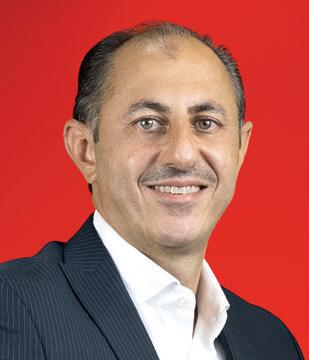
DHL Global Forwarding’s decarbonised range of GoGreen Plus products for air and ocean freight is aimed at making its operations more sustainable. Its Green Plus Service pro vides real emissions reductions through carbon insetting, a process through which a company offsets its emissions through a carbon offset project within its own value chain. Emissions are reduced by replacing the amount of conventional fossil fuel needed with sustainable fuel. Customers can easily pick and choose which parts of their supply chain they want to truly decarbonise.

Finally, more efficient processes can also contribute to sustainable operations. These include fast order fulfillment, which is bound to influ ence trip volumes, says Soham Chokshi, CEO and co-founder of Shipsy. “To reduce carbon footprint and build sustainable supply chain operations, businesses must embrace smart logistics management tools. Such tools can help companies achieve sustainability goals by reducing miles travelled, increasing first attempt deliveries, eliminating empty miles, decreasing trip volumes, improving resource utilisation and curbing paper usage.”
With all these opportunities on offer, logistics service providers can easily go the distance towards a sustainable future for the sector.
 Alaa Saoudi
Alaa Saoudi
gulfbusiness.com July 2022 47
SCAN GLOBAL LOGISTICS HAS RECENTLY INVESTED HEAVILY IN SUSTAINABLE AVIATION FUEL, THIS FUEL HAS THE POTENTIAL TO REDUCE CO2 EMISSIONS BY UP TO
Mads Drejer
Soham Chokshi
THE FUTURE OF LOGISTICS IS HERE

Special Report / Technology EXPERTS FROM ACROSS THE REGION’S LOGISTICS AND FREIGHT SECTOR GIVE US THE LOWDOWN ON ADVANCED TECHNOLOGIES, DIGITISATION, E-COMMERCE AND OTHER KEY TRENDS TRANSFORMING THE SECTOR WORDS: NEESHA SALIAN
Despite the recent slowdown caused by the Covid-19 pandemic and ongoing supply chain disruptions, the global transport and logistics sector market is set to grow robustly from around $8tn in 2020 to around $12.8tn in 2025, according to a report by strategy& titled, ‘Modernizing Gulf Logistics Through Digitization’.

The report attributes the growth to an increase in global trade activities and commodity exports from developing economies, more global and regional trade-related agree ments, the expansion of e-commerce, investments in logistics infrastructure around the world, technological advances, and the enabling and efficiency effects of digitisation on logistics.
Technology, in particular, has had the most compelling impact on logistics and supply chain. Dr Shereen Nassar, global director of Logistics Studies, Edinburgh Business School, Heriot-Watt University Dubai, says: “The internet of things (IoT) has been one such impactful technology that has revolutionised many industries. It has helped compa nies become more agile and efficient. Cloud technology and mobile computing have also been beneficial for the sector and changed aspects such as planning, sourcing and distribution. Cloud-based solutions can also minimise cost and provide real-time data on various parts of the supply chain journey.”
Smart-analytics-powered dashboards, on the other hand, are helping global businesses gain visibility over third party logistics, or 3PL, operations and their own fleet performance. Data analytics aggregate delivery KPIs to improve decisionmaking and help identify optimisation opportunities.
Artificial intelligence (AI) though remains one of the big gest trends that has benefitted the supply chain industry. “It is helping supply chain stakeholders build self-governing and sustainable logistics processes, while predictive intelligence is allowing businesses to build proactive logistics networks by gaining critical insights into delays, exceptions and emergen cies,” says Soham Chokshi, CEO and co-founder of Shipsy, a logistics software solutions provider.
“On the other hand, blockchain enables busi nesses to drive high levels of trust, transparency and financial traceability across supply chain net works,” he adds.
Robust market
The UAE, which ranks 11th globally in the World Bank’s Logistics Performance Index, is focused on adopting technological advancements to tackle demand and supply, sustainability issues and growth.
Amadou Diallo, CEO of DHL Global Forward ing, Middle East and Africa, says, “The UAE has always been a key market for us, as it continues to invest in infrastructure and road capabilities to meet the growing demand for global trade. The country is also witnessing a boom in e-com merce, as is the region.” According to Statista, the
THE E-COMMERCE MARKET IN THE GCC IS BOOMING, EXPECTED TO GROW FROM $24BN IN 2020, TO REACH
$50BN BY 2025
e-commerce market in the GCC is booming, expected to grow from $24bn in 2020, to reach $50bn by 2025.
Diallo says the increasing demand has put enormous pres sure on logistics providers “to automate their operations to reduce labour-intensive processes via technology investments and the incorporation of workforce flexibility. We are lever aging technology to provide customers with more accessible tools to manage shipments and supply chains”.
Automated storage and retrieval systems have been key to help find, pick and move inventory around to help compa nies meet the tight delivery deadlines that are associated with e-commerce. Companies such as Aramex have also rolled out technological solutions to improve accuracy in pick-up and delivery. “We have partnered with what3words to further boost the last-mile service with an improved and accurate address system. The integration supports regional SMEs who are looking to optimise customer experiences and offer better customer service,” says Alaa Saoudi, COO at Aramex.
gulfbusiness.com July 2022 49 Special Report / Technology
Robotics and drones


Robotic solutions are also game-changers, says Diallo. “Increasing automation will drive the use of robotic solutions in warehouses, which will result in enormous time and monetary savings for businesses.”

Companies are also looking to use autonomous drones for warehouse inventory management. dnata is one of them. The company is planning to launch them at its warehouses at Dubai International Airport and Dubai World Central. The drones aim to digitise acceptance and warehouse inventory processes by monitoring shipment with up to 99.8 per cent accuracy. They are paired with a tablet and provide live inventory data. The collected data can be viewed directly on the tablet or via an app. Guillaume Crozier, senior vice president, dnata, says: “Our partner’s innovative so tware enables the drones to map the environment, collect inventory data, count cases, measure temperature and read barcodes using only their cameras, without the need for any additional active infrastructure.”

The company is also working on a next-generation e-commerce system. Crozier adds, “Customers will be able to integrate the platform into existing workflows through APIs
(application programming interfaces) and take advantage of all innovative functions while using their own system. The platform will also help customers simplify existing processes, without investing in multiple systems. Furthermore, it will enhance sustainability by promoting paperless and cashless trade through collaboration and automation.”
Companies of all sizes – from e-commerce sites and SMEs to shippers, couriers and delivery services – can benefit from using logistics APIs. The APIs can be used to drive business agility and enhance customer experience, among other functions. Henrik Ambak, senior vice president at Emirates SkyCargo, says APIs are the new enablers of simpler interaction between systems. “They are digitalising the commercial process (tari distribution, spot quotations and booking) which, helped by algorithm-based solutions, enhance the ability for airlines and our forwarding partners to optimise the price of each transport.”
Going forward, the future of logistics seems centred on e ciencies and peer-to-peer servicing, says Ashrith Sudhir, Marketing Manager, IQ Fulfillment. “These will be enabled by technologies such as automation (at the warehouse, transportation, etc.) and IoT that allows multi-platform connectivity and end-to-end planning cycles. Such initiatives will allow for better resource utilisation, waste elimination and ultimately, an e cient global supply chain.”
gulfbusiness.com50 July 2022
The UAE has always been a key market for us, as it continues to invest in infrastructure and road capabilities to meet the growing demand for global trade. The country is also witnessing a boom in e-commerce, as is the region”
Special Report / Technology
Amadou Diallo
99.8%
DRONES CAN DIGITISE ACCEPTANCE AND WAREHOUSE INVENTORY PROCESSES BY MONITORING SHIPMENT WITH UP TO ACCURACY
Digital transformation
COMMENT Rodrigo Campos, COO of Hyke

Digital distribution is the way forward
In addition, digital distribution technologies and platforms have made it possible for retailers to access a larger range of products, to order anytime from anywhere, track their orders more efficiently and receive real-time updates on the status of their deliveries. This has led to a need for improved communication and coordination between suppliers and retailers.
Thewholesale distribution industry has undergone a significant transforma tion in recent years, driven by the rise of digital technologies and platforms. This has enabled better supply chain management for wholesalers, as well as new opportunities for growth and expansion.

Digital distribution has revolutionised the way the wholesale industry operates. It has enabled the industry to move away from traditional ways of selling and distributing goods, toward a more efficient model that removes friction and prioritises speed and efficiency of ‘go-to-market’ models. This has also had a profound impact on the way businesses operate, as well as the way the traditional trade purchases goods.
The rise of digital transformation in the whole sale distribution industry has been a boom for businesses and consumers alike. It has made it possible for suppliers to reach a larger number of retailers more easily, quickly and efficiently, than ever before. This, in turn, has led to an increase in competition among suppliers, as well as an increase in the number of customer enquiries and orders that need to be processed.
The traditional inventory management model was based on the premise that businesses needed to maintain a certain level of stock to meet customer demand. This often resulted in businesses stockpiling inventory, which tied up significant working capital. In addition, the process of physically managing inventory was often inefficient and prone to errors. Digital distribution has revolutionised the way in which businesses manage their inventory. By digitising the inventory management process, businesses can gain real-time visibility into their stock levels. This allows them to make more informed decisions about the inventory status they need to maintain, ultimately resulting in improved efficiency and lower costs. In addition, digitising the inventory management process has enabled better business supply chain management. Businesses can identify bottlenecks and optimise their operations by having visibility into the entire supply chain. This results in a dramatically improved, more optimised supply chain that is better able to meet customer demand. Another significant impact of digital distribution technologies and platforms on the wholesale industry has been the way that they have changed the relationship between suppliers and customers over the years.
Wholesalers can benefit greatly from harnessing the power of a digital distribution platform. By utilising a digital distribution platform, wholesalers can keep their supply chain running smoothly and efficiently. They can access a wealth of data that can be used to optimise their supply chain. By using data from a digital platform, wholesalers can identify trends and patterns that can help them improve their operations significantly. By automating the entire process, it also reduces the scope of manual errors and delays for wholesalers, in addition to saving costs.
In the early days of digitisation, the focus was on compliance, quality and security standards. However, as digital distribution expands its footprint, those elements have been simplified, and the emphasis has shifted to the identification of new business models and the need for more flexible solutions.
gulfbusiness.com July 2022 51
Digital distribution has revolutionised the way in which businesses manage their inventory, bringing in efficiency and improved coordination between retailers and suppliers
The key to the supply chain conundrum


Research shows that only 12 per cent of companies are sufficiently prepared for global supply chain disruptions. We look at how organisations can identify lapses and start the process to address them
“It’snot what you don’t know that kills you, it’s what you know for sure that just ain’t so.”
This article could begin and end with this quote by Samuel Langhorne Clemens, better known by his pen name Mark Twain. We believe he also deserves recognition as a founda tional thinker in the domain of supply chain.
After a decade of big data and advanced ana lytics, with digital on the rise, and building on a century of development in supply chain domain knowledge, we have globally witnessed some of the most spectacular, surprising and incapacitat ing collapses of trade flows in these last few years. Our recent research in collaboration with the World Economic Forum shows that only 12 per cent of companies are sufficiently prepared for global supply chain disruptions. There are three
points of failure and none of them can be fixed by your supply chain organisation:
OVER THE HORIZON: Even the best organisations use a narrow definition of supply chain, focusing on the physical flows, across tiers. Rarely do they integrate critical enablers such as upstream labour and financing, which are critical to supply chain planning and disaster recovery; a fact exposed when labour was impacted by the pandemic and when liquidity dried up during the 2008 financial crisis. These critical enablers do not move along the supply chain but can still cause disruptions.
IN-HOUSE: Supply chain ultimately reports to shareholders. The mission is to be efficient, operating “Just-In-Time”. These supply chains are fragile, prone to sudden collapse and require extensive trouble shooting to fix. “Just-In-Case” supply chains, catering to spooked shareholders and embracing some emerging themes of ESG, are now making headlines, but will struggle to survive.
Hundreds of companies polled after key crises affecting supply chains showed a consistent pattern: they launched advanced initiatives to rehaul their supply chains while they were hurting, but quickly returned to business as usual when the light at the end of the tunnel convinced investors to choose short-term efficiencies, over expensive protection from hypothetical black swans.
INTO THE LOOKING GLASS: Supply chain departments can have a narrow scope. They are alert to risk drivers and alarm triggers dotting
gulfbusiness.com52 July 2022
their own multi-tier networks. However, rarely do they contemplate contiguous supply chains. They focus primarily on identifying redundancies for their own suppliers and routes. While these are plugs for isolated issues, they are not necessarily a viable approach to systemic breakdowns. So is everybody running dysfunctional supply chains? Of course not. According to UNCTAD, the value of global trade increased tenfold from 1980 to 2020, a clear sign of sustained trust and effectiveness, but this has amplified dependencies and ripple effects.
Some are supremely good at adapting to the changing conditions. For example, military supply chains in the UAE responded to the Covid-19 crisis with shock-and-awe effectiveness.
Within 24 hours of the WHO declaring the pandemic, they had assembled a must-have list, briefed the embassies, and responded with an action plan within 48 hours. By the end of the first week, repurposed planes were coming back loaded with the supplies. Once the surge was over, they huddled to address one question: How can we do this better?
At the other end, we are witnessing cases where all stages involved are actively worsening the crisis: A lack of truck drivers in the US has kept containers on ships waiting to be offloaded, ship carriers have charged high fees for waiting times, and commodities are coming in late and more expensive. Fewer drivers are enjoying higher pay, carriers are running margins over 50 per cent up from traditional single digits, and the supply chain is overheated with delays and costs.
There are two lessons that can be of inspi ration, when trying to remain effective in sus tained turbulence:
1. BECOME MULTILINGUAL: To inspire a dialogue in a world we do not understand, but
Supply Chain
insist on predicting, the supply chain needs to adopt three languages. The first is the language of planning, that organisations use to set targets for a predictable world. The second is a language of reassurance, for continuity plans that assure stakeholders. These are widely spoken. The third, lesser used language is to be more agile, where teams need to quickly adjust its strategies, particularly in procurement, inventory management and delivery, to meet rapidly changing supply chain requirements.
Having an agile supply chain by reacting effi ciently to changes, delays and unexpected events will help companies maintain customer expecta tions and stay competitive.
2. THINKING CAPS FOR TODAY, TOMORROW, AND BEYOND: There are three thinking caps that organisations can put on to develop mitigation strategies.
The12-36monthsthinkingcap: Leading organ isations have started to expect to be wrong. As a remedy, they identify a few, key metrics that indicate on-coming change and develop enough agility to respond to these anticipated changes. It’s a tough discipline to change fast on weak signals. The36-60monthsthinkingcap:Military, govern ments, and global food companies, among others, resort to scenario planning to develop detailed descriptions of possible futures, shaped by differ ent outcomes in key trends, such as changing gen erational preferences and climate change. Through this, they derive lessons on what it would take to adapt, and develop the capabilities to change. Thenightthinkingcap:A tsunami, a geopolitical crisis, are recent examples of shocks that we did not see coming. Leading edge organisations make use of ‘Wargaming’, having their teams simulate a response to disruptions, with the purpose of having them fail, to learn from the process.
Think food – it’s familiar to all. Global food trade systems are geographically sprawling, tem porally expansive, structurally connected, thus enhancing fragility to disruptions that can per meate the global network. To get poultry to a fast food restaurant in the GCC, trade among 65 coun tries needs to happen on 676 trade routes. No one can reliably plan around this, but war gaming can show you all the different ways you can fail.
The biggest factors to come to terms with are that exposure remains high, disruptions are frequent, and consequences are unclear at the outset. To remain effective, organisations need to fix points of failure around the supply chain, not only within.
gulfbusiness.com July 2022 53
“A TSUNAMI, A GEOPOLITICAL CRISIS, ARE RECENT EXAMPLES OF SHOCKS THAT WE DID NOT SEE COMING. LEADING EDGE ORGANISATIONS MAKE USE OF ‘WARGAMING’, HAVING THEIR TEAMS SIMULATE A RESPONSE TO DISRUPTIONS, WITH THE PURPOSE OF HAVING THEM FAIL, TO LEARN FROM THE PROCESS”
Federico Mariscotti, vice president of the strategic operations practice, Kearney Middle East
TO GET POULTRY TO A FAST FOOD RESTAURANT IN THE GCC, TRADE AMONG
65
COUNTRIES NEEDS TO HAPPEN ON
676
TRADE ROUTES
Going the extra mile
AMAZON’S NEWEST DELIVERY STATION ENABLES SWIFT LAST MILE DELIVERY TO CUSTOMERS THROUGHOUT ABU DHABI
 By Zubina Ahmed
By Zubina Ahmed
PICS: SUPPLIED gulfbusiness.com54 July 2022 Special Report / e-commerce logistics
THE LAST MILE
There are many teams who are involved in the backend process at Amazon’s facility, from receiving the products in the warehouse to sorting, packing and shipping them. They ensure operations run smoothly, particularly with so many variables in place, says Lee Shepherd, director - Amazon Logistics, MENA Operations. He adds that this process is con stantly fine-tuned for enhanced efficiency.

“We receive thousands of packages here every day, and have a five-way process in place to ensure packages are shipped to their final destination seamlessly,” states Shepherd.
Everytime we shop online, we simply click and wait for the product to reach our doorstep a few days later. Did you know that ensuring speedy, seamless and timely product delivery involves a highly struc tured and organised back-end process? Gulf Business recently visited Amazon’s largest delivery station in Abu Dhabi to get the rundown on this operation. Based in Abu Dhabi, and spread over an area of 4,700 square metres, this newly opened delivery sta tion, Amazon’s second-largest in the UAE, provides same-day and next-day deliveries to customers across the capital city
TRACKING AMAZON’S GROWTH IN THE UAE
Inthe past few years, Amazon Middle East has expanded its footprint in the region to meet customer demand. In the UAE, the Amazon network comprises two fulfillment centres, three sort centres, eight delivery stations, and a network of delivery service partners.



Growth in the UAE
Lee Shepherd, director Amazon Logistics, MENA Operations says, “Since the launch of amazon.ae in 2019, we have been expanding our footprint to better service locations across the UAE with
speed, convenience and reliability. In 2021 alone, our investments included an increase in our delivery network floor area by 70 per cent, to speed up customer deliveries and enable sellers to reach more customers faster. We also increased the capacity of our fulfillment centres by 60 per cent to store millions of products for sellers and provide customers with a wider selection of products.”
Supporting the economy Services like same-day and oneday delivery, through Amazon Prime, are now achievable for
small businesses. “Local delivery companies deliver thousands of packages on our behalf every day, supporting indirect job creation and knowledge sharing. Many small and mediumsized businesses have ventured into e-commerce for the first time, using our simple and convenient process to start selling online, complemented by access-to-listing tools, safe payment processing, promotional features and customer service,” concludes Shepherd.
gulfbusiness.com July 2022 55
Lee Shepherd, director, Amazon Logistics
Special Report / e-commerce logistics

IT ALL STARTS AT THE…
Induct area: When packages arrive at this delivery station, associates work in symphony with the backend technology to sort packages by the delivery route. At the intake area, the associ ates scan each package, so that the computer can print out a label with the routing information. In addition to providing the ‘route’ code, the tech nology also identifies the sequence of delivery for the package.
Sorting area: Once the packages have been assigned a delivery route, they are sorted into racks or bins. Each rack or bin represents a delivery route, making it easy for the associates and delivery drivers to batch deliveries together.

Loading area: Packages are scanned and loaded into a delivery vehicle in this area. Deliv ery drivers use a special app on their phones to scan all the packages on a designated rack or bin, as they load the packages into their vehicle. This also alerts the backend systems that the package is now officially out for delivery.


Ship and deliver: Remember the label that was printed and attached to the package at the beginning of the sorting process? The same label also includes the stop number on the deliv ery route – it helps drivers determine the order in which to load packages into their vehicle. Once loaded in the most optimised order, the driver has access to packages in the order of deliv ery. Customers can also easily track their orders through the app or through email or SMS, which alerts them when a driver is about to reach their location.
“Customers expect transparency, accuracy, speed, convenience and a lot of this depends on the last mile,” states Lee.
gulfbusiness.com56 July 2022
Reverse Logistics
Mohammad Sleiman, founder and CEO, Cartlow
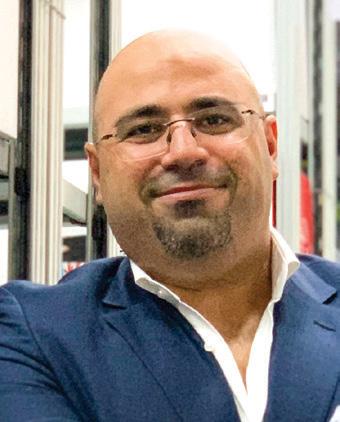
How reverse logistics supports sustainability
The goal of reverse logistics is to maximise the asset value, creating a focal point to recycle products and materials
Ashumanity continues to populate and expand its presence across the globe, the snowballing effect of waste, in particular, e-waste, is trickling in a noticeable path. With experts predicting the annual generation of e-waste reaching 74.7 metric tonnes (Mt) by 2030, businesses have had to accelerate the implementation of several meas ures to reduce their environmental footprint, one of which includes the use of reverse logistics.
The phenomenon of reverse logistics refers to the supply chain management process whereby consumer goods are moved from customers back to the sellers or manufacturers, resulting in the reuse of products and materials. By sourcing and purchasing open-box, clearance, faulty and dam aged products, companies ensure sustainability in their supply chain operations by recycling, refur bishing or reusing these goods, prolonging the ‘end of life’ phase in their development cycle, which has become increasingly crucial to the environment.
Addressing e-waste

Reverse logistics is a promising solution to tackling e-waste due to high-speed technological advancements. With 53.6 million metric tonnes of e-waste recorded in 2019, global electronic wastage is set to increase due to rapid technological advances, economic growth, urbanisation processes, and the increasing demand for consumer electronic equipment worldwide annually. Businesses have entered B2B partnerships, where electronic components that may be salvaged are “harvested” and then sold from business A to business B for repurposing. Instead of outdated, “open-box, and clearance products entering landfills, they are given the opportunity to an “another life”.
BUSINESSES HAVE ENTERED B2B PARTNERSHIPS, WHERE ELECTRONIC COMPONENTS THAT MAY BE SALVAGED ARE “HARVESTED” AND THEN SOLD FROM BUSINESS A TO BUSINESS B FOR REPURPOSING
The goal of reverse logistics is to maximise the asset value, creating a focal point to recycle prod ucts and materials. The process consists of sev eral aspects including repairing broken products and allowing them to then be sold at heavily dis counted prices, repacking open-box items, recy cling materials that are inoperable, and material harvesting, which enables companies to extract the materials from damaged products and utilise them to fix other items.
Beyond logistical and economic benefits, reverse logistics contributes substantially to sustainability. The circular economy promotes a longer product life cycle as items are either repaired or repackaged and then travel back through the supply chain, providing a second chance for purchase and ulti mately avoiding contributing to global waste.
Responsible recycling
Global garbage is expected to reach 3.4 billion tonnes by 2050, a shift in the amount of waste ending up in landfills is desperately needed in order to protect the future of the environment we live in. Businesses and individuals can take several steps within their lives to create positive environmental impacts, including the use of reverse logistics.
The promising potential for “responsible recycling” is probably one of the most significant factors when considering whether to include reverse logistics in an end-end supply chain. Between the burgeoning demand to swiftly “rid products and electronics” and factoring in the operational costs to effectively recycle, businesses who adopt B2B partnerships are left with smaller and more manageable recycling “piles” that can be maintained effortlessly without compromising their business operations or the environment.
Adapting reverse logistics within a company’s supply chain is in line with the UAE’s Vision 2021 to improve air quality, preserve water resources, increase the contribution of clean energy and implement green growth plans. The green circular model is a given alternative to reducing the nega tive impacts of the supply chain. Seeing that the effects of logistics have become more transpar ent to customers, the call to businesses to factor reverse logistics into their supply chain model is almost imminent.
With the rapid build-up of external pres sures in the distribution market, it is becoming increasingly crucial for all companies to consider a reverse logistics approach that will provide envi ronmental, economic, and supply chain advan tages for their short and long-term goals.
gulfbusiness.com July 2022 57
COMMENT





















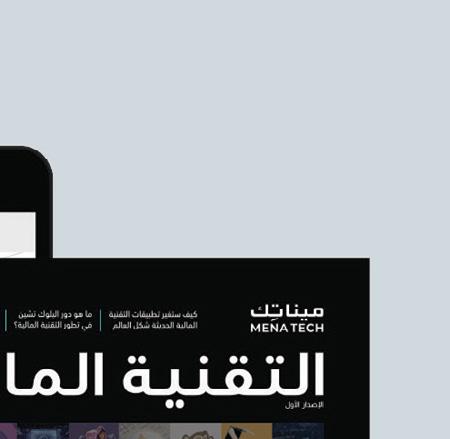






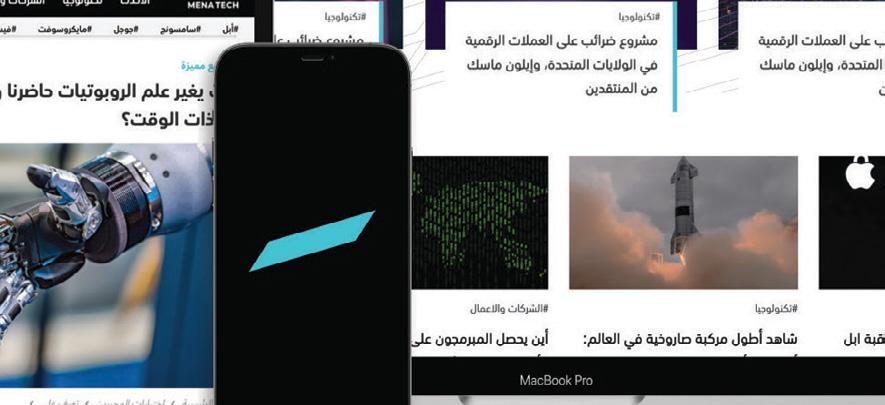
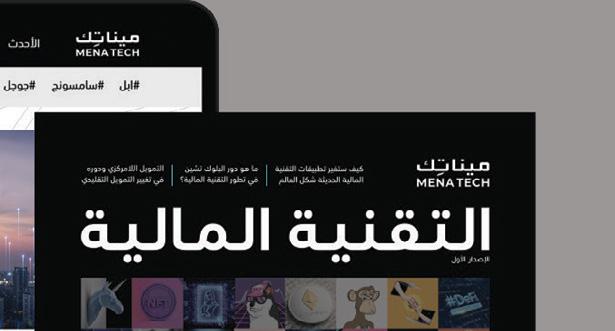


C M Y CM MY CY CMY K
Lifestyle
Spotlight on Switzerland


Combining the highest standards of medical care with exclusive service, Switzerland is rated among the top global destinations for health travel p.66



Omega Seamaster



















The Seamaster Aqua Terra’s 2022 collection comes in two sizes (34mm and 38mm) and a range of dial shades, including blue and green. The 34mm models have 18k white gold hands and indexes



22 gulfbusiness.com July 2022 59
“Dubai Summer Surprises has been at the heart of Dubai’s summer season for a quarter of a century, shaping memories and creating unforgettable experiences for everyone in our great city”
Ahmed Al Khaja, CEO, Dubai Festivals and Retail Establishment
JULY
A summer of surprises
Dubai Summer Surprises, which celebrates its 25th anniversary this year, starts on July 1, promising a series of activations, sales, prizes and entertainment

 BY ZUBINA AHMED
BY ZUBINA AHMED
InDubai, summer not only brings soaring temperatures, it also marks the return of Dubai Summer Surprises, the annual shopping festival popularly known as DSS.
Currently in its 25th edition and organ ised by the Dubai Festivals and Retail Establishment (DFRE), DSS is scheduled to run for ten weeks from Friday, July 1 to Thursday, September 4. This year’s festi val is specially curated – from featuring a “25-hour” sale to mark its anniversary, to offering discounts of up to 75 per cent at major retail outlets across the city. As is tradition, there’s also a mega raffle prize to be won.
“Dubai Summer Surprises has been at the heart of Dubai’s summer season for a quarter of a century, shaping memories and creating unforgettable experiences for everyone in our great city. This year is no exception, with a programme that showcases the very best that Dubai has to offer across our malls, restaurants, hotels and more,” says Ahmed
A RETAIL HUB
The popular shopping festival underpins Dubai’s dynamic retail sector. “Retail as we know is a major driver of the growth of Dubai’s economy and contributes to one third of its GDP. In fact, Dubai is seen as a

launchpad for regional expansion by local, regional and international retail brands. It ranks as number one in overall international retailer presence, with more than 62 per cent of the world’s brands having some sort of footprint here,” says Mohammed Feras, director of retail registration at DFRE.
Feras attributes DSS’ continuing success to the strong partnership between DFRE and major retailers in the region.
The shopping festival, which livens up the atmosphere across Dubai’s malls, con tinues to attract more international visitors every year.
“Shopping malls are part of the social fabric of the city, where people go not only to shop, but also to socialise. This factor – in addition to fantastic retail and entertainment offerings – has seen the city’s malls welcome more than 80 million visitors annually,” says Feras.
Visitor numbers will swell further boosted by the global recovery of tour ism and Dubai’s reputation as a safe travel destination in the face of the Covid-19 pandemic. This is clearly evident by the number of visitors the emirate welcomed in the first quarter of the year.
According to the latest data released by Dubai’s Department of Economy and Tourism at its first ‘City Briefing’ for 2022, Dubai wel comed 6.17 million international overnight
Lifestyle / Shopping
Al Khaja, CEO, Dubai Festivals and Retail Establishment.
gulfbusiness.com60 July 2022
visitors from January to May. This is a 197 per cent year-on-year increase from the same five-month period in 2021, which saw
the city attracting over two million inter national travellers. Feras, who shares that DFRE’s retail calendar includes a total of 18 events throughout the year, is looking forward to welcoming more visitors this summer. “The number of exciting activa tions we have during DSS showcases Dubai as a major shopping destination for tour ists, visitors and residents,” he adds.

SO , WHAT’S IN STORE?
During the shopping extravaganza, people can enjoy offers across 800 brands in 3,500 outlets and avail discounts of up to 25 to 75 per cent. Offers will be unveiled daily, 24 hours ahead of time and valid from



10am until stocks last. There will also be an exclusive, specially-curated flash sale on hotel stays, which will only be available for 24 hours.
Expect live concerts, music events, live performances and decorative lighting installations throughout the city. Visitors can also take part in colourful parades such as the 25th Anniversary Silver Parade and carnival parade. Official mascots Modhesh and Dana will also make their presence felt at malls and venues across the city.
And last but the least, food lovers can look forward to Summer Restaurant Week, which returns from August 12 until 28. For a limited time, visitors and residents can explore 50 of Dubai’s best restaurants, with special breakfast, lunch and dinner deals at discounted prices.

Lifestyle / Shopping
According to the latest data released by Dubai’s Department of Economy and Tourism at its first ‘City Briefing’ for 2022, Dubai welcomed 6.17 million international overnight visitors from January to May
gulfbusiness.com July 2022 61
DURING THIS SHOPPING EXTRAVAGANZA, PEOPLE CAN ENJOY OFFERS ACROSS 800 brands in 3,500 outlets AND AVAIL DISCOUNTS OF UP TO
75
per cent
DUBAI’S MALLS, WHICH ARE MAJOR GLOBAL TOURIST ATTRACTIONS, RECEIVE MORE THAN 80 million VISITORS ANNUALLY
Reimagining luxury hospitality
Fredrik Reinisch, complex general manager at Habtoor Hospitality Group in Dubai, talks to Gulf Business about Al Habtoor City Hotel Collection and how its offerings have positioned it as one of the emirate’s top hospitality destinations
 BY NEESHA SALIAN
BY NEESHA SALIAN
Tell us about Al Habtoor City Hotel Collection and its customer profile.
The collection consists of three hotels: Hilton Dubai Al Habtoor City, V Hotel Dubai – Curio Collection by Hilton, and Habtoor Palace Dubai – LXR Hotels & Resorts. The three hotels have their own distinct character and customer profile.

As a global icon, Hilton naturally receives a strong and well-balanced mix of customers.
Habtoor Palace Dubai is the lieu de vie for royals, officials and celebrities, who want an opulent yet private retreat that ele vates the experience of every single guest, as they often travel with their entourage. V Hotel Dubai, on the other hand, is more
fitting for young entrepreneurs, CEOs and business owners who like congregating to exchange ideas in a setting that’s both styl ish and contemporary.
We’ve seen fantastic growth and potential in segments such as consortia, corporates, frequent individual travellers and families – typically multi-generational guests –thanks to our large inventory of connected suites and rooms, which also transform into mini-apartments, making it one of the most versatile and comprehensive offers in the luxury hotel market in the emirate.
In addition, Al Habtoor City Hotel Col lection is positioned as an urban integrated complex with ample MICE (Meetings, Incentives, Conferences and Exhibitions) services and facilities at a very central loca tion in Dubai.
What are some of the key highlights of the hotels?
Our hotels feature gems such as Le Patio at the Habtoor Palace Dubai, with its open-air atrium that is reminiscent of Parisian pal aces; and the Sir Winston Churchill Suite, which epitomises luxury in the true sense. The three-bedroom suite offers stunning views of landscaped gardens and fea tures an in-room staircase that connects to a rooftop plunge pool and an expansive majlis to host guests in a private setting.
Habtoor Palace Dubai’s exclusive cus tom-designed Bentley Suite, which is inspired by the bespoke craftsmanship of the flagship Bentley Mulsanne, is yet another highlight.
We are also home to the Las Vegas-style aqua show, La Perle, created by well-known artistic director Franco Dragone. The stunning show features more than 60 per formers from over 20 countries performing acts such as acrobatics, aerial feats, diving
Lifestyle / Hospitality
gulfbusiness.com62 July 2022
Fredrik Reinisch
“One of our biggest USPs is our great location – in the heart of Dubai along the water canal, where guests can arrive by road on Sheikh Zayed Road, by water via an RTA water taxi, or by air as they land on our private helipad”
and even motorcycle stunts that defy grav ity. One of our biggest USPs is our great location – in the heart of Dubai along the water canal, where guests can arrive by road on Sheikh Zayed Road, by water via an RTA water taxi, or by air as they land on our private helipad.
What are the central themes driving your food and beverage (F&B), and entertainment strategy?
Al Habtoor City is a destination within a des tination. It features Al Habtoor City Hotel Collection, which includes more than 30 dining venues including bars and lounges, three rooftop pools, two spas, and the high est bowling alley in the world at The 44.


The Winter Garden, which we host every year during the winter season, is one of Dubai’s most anticipated events. The fam ily-friendly outdoor event features F&B offerings, a play area for children, pop-up shops and a lot more.
We’ve also introduced a brand new ‘culi nary staycation’, where guests can reserve a room at any of the three hotels and enjoy our half board and full board offers, which feature meals engineered by recently appointed complex executive chef Nicho las Shadbolt and executive sous chef Deniz Katranci. The staycation includes compli mentary tickets to the La Perle show.
Additionally, the La Perle show can be teamed with dining packages at restau rants across all three hotels, highlighting both our entertainment and dining offer ings to guests.
And it’s not just the hotels that offer fine dining: Al Habtoor City Boulevard is home to Il Pastaio – Beverly Hills’ most popular Italian restaurant and Gonpachi, the iconic Tokyo restaurant where the movie Kill Bill was filmed.
What was the impact of Expo 2020 on business?
The emirate welcomed around 20 mil lion visitors during Expo 2020 and this has had a direct and pro ductive impact on Dubai’s hospitality sector. During this period, we also benefit ted from exclusive events that attracted domestic and international visitors to the city. These included the Emirates Literature Festi val, which was staged across 400 rooms at Habtoor Palace Dubai and 15 banquet venues within Al Habtoor City Hotel Collection. We also hosted
international delegates and guests – in 1,000 rooms for four days – who attended an event organised by the Prime Minister’s Office. The World Police Summit, hosted by Dubai Police at Dubai World Trade Centre, attracted more than 2,000 dele gates and 10,000 visitors, many of whom stayed with us.
Tell us about your latest offerings.
We recently launched ‘Indian Bazaar’, our new Indian-themed nights at Level Seven in V Hotel Dubai – Curio Collection by Hilton. We’ve relocated Taikun at the Hilton Dubai Al Habtoor City; it features theatrical cabaret performances to entertain guests during dinner. The newly-opened restaurant Sirali offers up Turkey’s 500-year-old culinary culture to diners through creative presentations. We’ve also introduced our brand new certified Kosher Kitchen for our Jewish guests from around the world.
What’s your outlook for the rest of the year? The second half of the year is going to be exciting with the upcoming Eid Al Adha break and the FIFA World Cup in Qatar, with Dubai being a pit stop for many fans.
Al Habtoor City Hotel Collection is wellpositioned as a hotel of choice for such guests considering the added benefit of being a 15-minute drive away from the airport. Tourism is also on the rise with international overnight visitors touching record numbers this year, and we look forward to seeing more visitors flying in to experience Dubai’s attractions and amazing hospitality.
Lifestyle / Hospitality
gulfbusiness.com July 2022 63
SHOWCASING OPPORTUNITIES
The Gulf Business - CMTrading event, held on June 16 at Pullman Downtown Dubai, gave attendees an insight into cryptocurrency, online trading and introducing businesses



Online trading, digital assets and cryptocurrencies have seen a significant increase over the past decade. Some frequently asked questions include: Is buying stocks online safe? What tips should you know before you start trad ing online? Are cryptocurrencies a safe investment? What is the most profitable way of trading? Most of these queries were addressed at a special event organ ised by Gulf Business and CMTrading on June 16 at the Pullman Downtown Dubai. The event, which saw fintech and invest ment experts interact with new and experienced traders, was a great success.
Established in 2012, CMTrading is an award-winning broker, offering over 150 products, including commodities, stocks, indices and cryptocurrencies. “To be successful, however, you need to partner with a trusted broker, then use a modern and friendly app that supports
and facilitates different investment tools to fit them to your needs. CMTrad ing ideally meets that objective and is perfectly positioned to empower eve ryone to become a trader through our award-winning platform,” said Ibrahim Abu Aita, founder of CMTrading at the event. “Ten years later, we’ve evolved into a growing global business running
in South America, Africa and Middle East. I can proudly say our business has stood the test of time, thanks to not only the founders, but also the dedicated and talented team – their contribution to the business was undeniable and admira ble,” added Ibrahim.
With more than one million subscrib ers, it has been a successful decade for CMTrading. “And now it’s time to level up for the next ten years. We will always seek new opportunities and overcome challenges with the same spirit and vision that have brought us so much success in the past,” con cluded Ibrahim.
The event gathered key speak ers from the finance industry for some thought-provoking discus sions on the current investment landscape – across three engaging panel discussions.
The theme of the first session was ‘Digital Assets and Crypto currency’. Moderated by Divsha Bhat, technology editor of Gulf Business, the speakers included

FEATURES / POST-SHOW REPORT gulfbusiness.com64 July 2022
Charlie Charalambous and Jonathan Bergman
Andreea Danila and Ibrahim Abu Aita
Saqr Mashhor Ereiqat, co-founder at Crypto Oasis; Ola Lind, chief strategy o cer, Future Fintech Group and director of FTFT subsidiary; and Ali Askar, a quant trader. It was an insightful panel where the speakers discussed the latest investment strategies, market trends, future of digital assets, recent regulatory developments and how to mitigate risks associated with crypto.

This was followed by a second panel session: ‘A Holistic Approach to Trading’. Moderated by Zubina Ahmed, the digital editor of GulfBusiness, the panel featured Vijay Valecha, chief investment o cer, Century Financial; Andreea Danila, founder and general partner of Global Millennial Capital; and Ibrahim Abu Aita, founder and CEO of CMTrading.
It was an impactful panel where the speakers talked about the challenges
and benefits of short-term trading versus long-term investments, key trading strategies in uncertain times and the rise of impact investing.
The third and final session for the evening was ‘Building Relationships with Introducing Businesses’. Moderated by Neesha Salian, editor of GulfBusiness, the panel featured Wilson Varghese, GM and head of operations - Middle East, Zurich Insurance; Charlie Charalambous, head of Global IBs (Introducing Businesses), CMTrading; and Rus Kolinko, co-founder and managing partnerof Hometree, a property valuation company.
This panel discussion stressed the importance of strong partnerships to build a business, and the impact of customer service.
A PRODUCTIVE PARTNERSHIP
IBRAHIM ABU AITA , CEO and founder, CMTrading



“A successful partnership is gained when both parties share the same values and see mutual goals. This is what CMTrading discovered when collaborating with Gulf Business. The attendance was great, the panel was professional and the discussions were intriguing. I’m happy and grateful for the diversity, organisation and great exposure. “
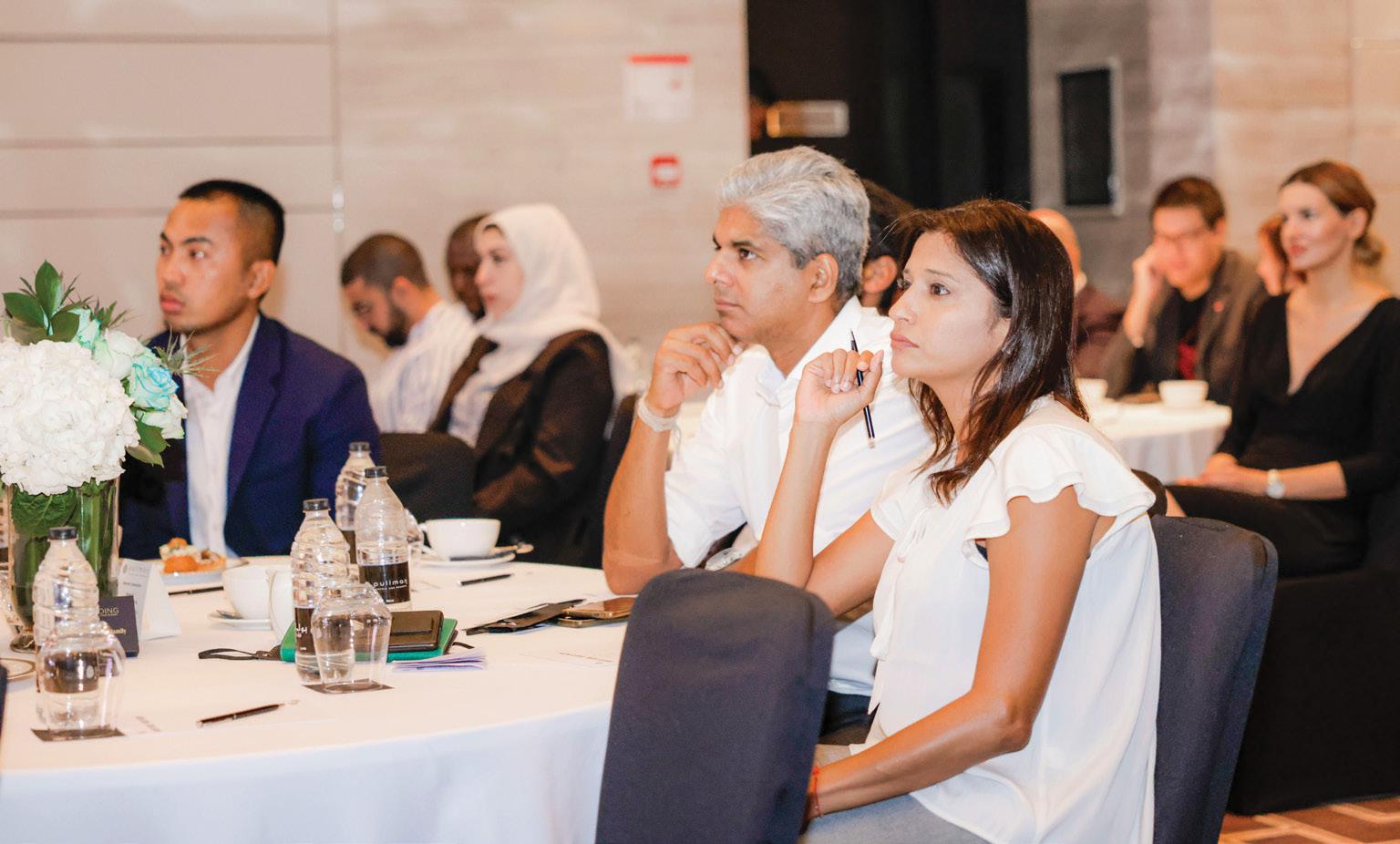
JONATHAN BERGMAN, director of marketing, CMTrading
“We believe finding the right partner is imperative to generating success and gladly Gulf Business was our partner in creating this event. Now it’s time to join our CMTrading partners programme and grow together.”
CHARLIE CHARALAMBOUS, Head of Global IBs, CMTrading
“Collaborations only work when there is a synergy, and this was definitely the case with Gulf Business. Both parties brought their expertise to the table, resulting in one of the best events we’ve ever held. I very much look forward to a continued partnership ahead.”
ANDREW WINGROVE, Group Director at Motivate Media Group
“We were pleased to co-host the event with CMTrading and bring in some key speakers from the industry who shared some amazing and contrasting insights on investments and trading. The panels were excellent; once they finished, we were pleased to see that the majority of our attendees stayed on to network with industry professionals and fellow investors. We look forward to a continuing collaboration with our partner CMTrading.”

FEATURES / POST-SHOW REPORT gulfbusiness.com July 2022 65
Bundling cure and comfort
SWITZERLAND CONTINUES TO BE A PACE-SETTER IN HEALTHCARE OFFERINGS

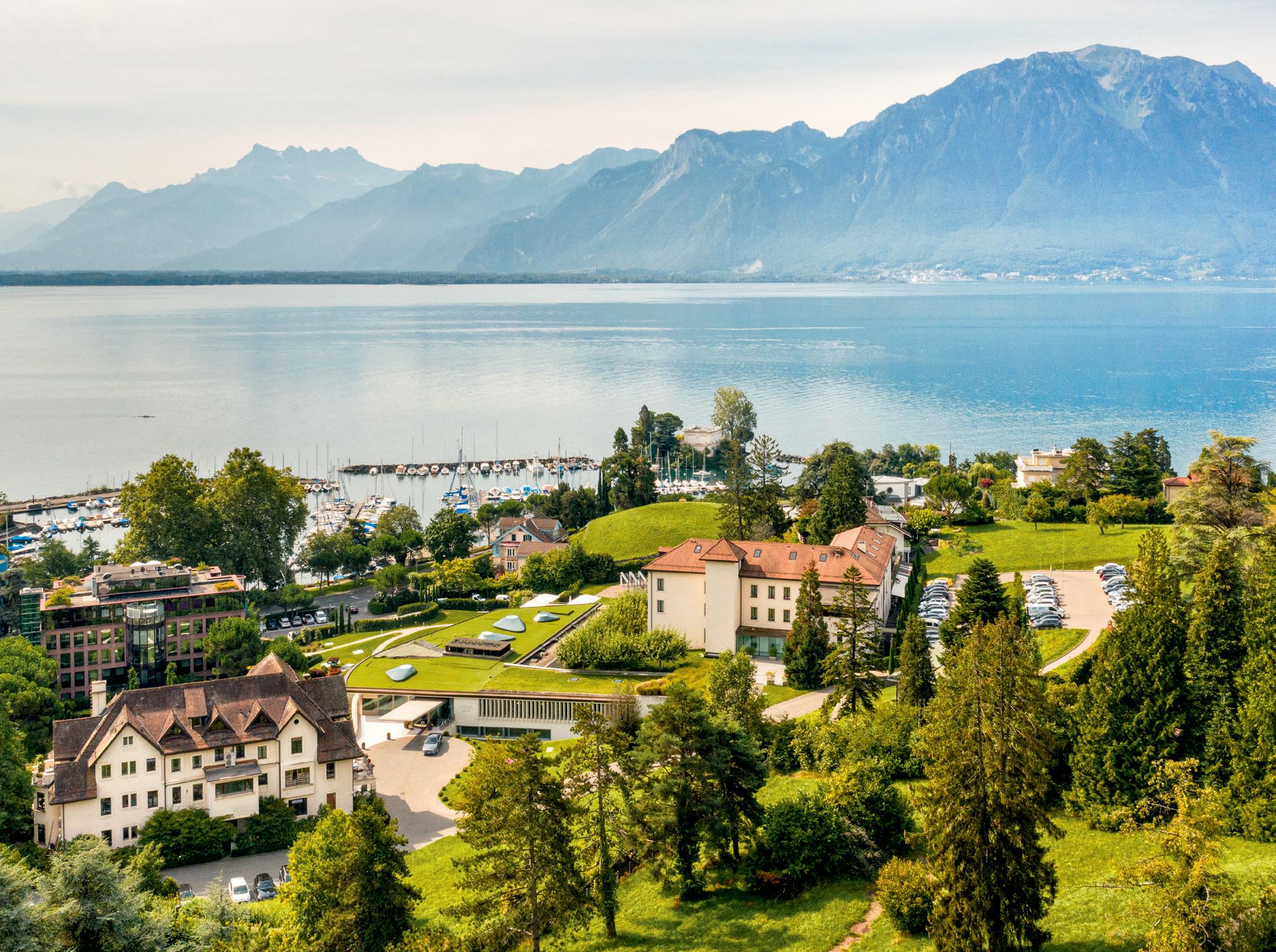 WORDS: ZAINAB MANSOOR
WORDS: ZAINAB MANSOOR
Switzerland has and continues to be one of the most soughtafter destinations for medical tourism. Besides offering pristine surroundings and sweeping views of nature’s boun ties – which act as a therapeutic source on their own – the Alpine nation offers a wide range of medical treatments, with individual ised healthcare services for its affluent patient base.
The Central European country, being home to healthcare heavyweights such as Roche and Novartis, is also a leader for breakthroughs, research and development (R&D) and medical innovation. In 2021, Switzerland bagged the top spot in the FREOPP (Foundation for Research on Equal Opportunity) World Index of Healthcare Innovation, rubber-stamping its position at the healthcare high table.
It’s understandable why. Switzerland’s health expenditure amounted to CHF82.472bn in 2019, equalling 11.3 per cent of gross domestic product, according to the Swiss Federal Statistical Office. Outpatient curative care including that provided in hospitals made up over one quarter (26.3 per cent) of costs. Meanwhile, H+ Swiss Hospitals, which is a national
MEDICAL TOURISM
gulfbusiness.com66 July 2022
association of public and private hospitals, clinics and special-care institutions, has members including 263 hospitals, clinics and special-care institutions in 369 locations, among others.
The country’s value proposition, how ever, lies in its diverse offerings, with Switzerland playing host to a plethora of medical clinics, hospitals and wellness centres offering patient-centric care. From people looking to pursue a wellness retreat or treat an urgent health condition to those wishing to unpack mental health issues or preserve their health via regular checkups, the European country runs the gamut of cure and care.
“Health travel is always undertaken for a specific reason, which can vary greatly from person to person. Everyone who trav els to Switzerland for medical care has their own individual reasons for doing so. Some times a serious medical condition makes immediate action necessary. In other cases, personal considerations may be the prior ity. Check-ups are geared to preserving good health over the long term. Mental health programmes seek to undo the damage that stress and difficulties in life wreak upon the body,” notes Matthias Albrecht, direc tor GCC at Switzerland Tourism.
Switzerland Tourism has tied up with around 30 hospitals and clinics to curate the country’s narrative around health tour ism and to align efforts to showcase the nation’s healthcare services and support ing infrastructure.


Given the country’s natural endowments, its popularity as a hot tourism spot and its robust medical and wellness services, Swiss healthcare providers often offer a layered health tourism experience, bun dling the best of offerings. “The stunning landscape also promotes relaxation. You and your companions can stay in a deluxe Swiss hotel or wellness facility during your time in the country. Or, if you wish to have a greater degree of privacy, characterful
chalets and luxury apartments are also available,” adds Albrecht.
But given that visitors are spoilt for choice, how does one zero in on the right medical facility? “Switzerland has an extensive network of highly specialised hospitals and clinics. Depending on your needs, you may have a selection to choose from. If that is the case, factors such as the service offered by an establishment and its geographical location within Switzerland are also to be considered in addition to its medical specialisms,” explains Albrecht.
A long-standing factor that has helped underpin Switzerland’s healthcare industry is the ethos on which it operates – extend ing high levels of privacy to foreign patients
and their families, whilst safeguarding their personal and medical information. This allows patients – mostly high-profile ones – the seclusion and space to pursue their treatments and/or convalesce, away from often intrusive media scrutiny in their home countries.
“Switzerland’s clinics and hospitals are characterised by the quality for which the country is famous for. It comes as no surprise, then, that the Swiss healthcare system is one of the best in the world,” notes Albrecht. “In keeping with the reserved mentality of the country’s citizens, the protection of privacy is guaranteed and high-profile patients can be treated undisturbed.”
However, does the process of roping in the right specialists, securing appointments and organising the stay become an arduous one? Not if there is the right kind of help around. “To ensure that your health travel to Switzerland runs like clockwork, you can choose to sit back and entrust the planning to our specialists. Swiss clinics have international support teams that can organise your entire stay. There are also agencies specialising in medical travel to Switzerland. All your questions about your medical treatment, transport and support for family members can be taken care of,” advises Albrecht.
Features / Medical Tourism
Swiss clinics have international support teams that can organise your entire stay. There are also agencies specialising in medical travel to Switzerland”
gulfbusiness.com July 2022 67 SWITZERLAND’S HEALTH
EXPENDITURE AMOUNTED TO
CHF82.472bn IN 2019, EQUALLING 11.3 PER CENT OF GROSS DOMESTIC PRODUCT
Rejuvenation for Body and Mind
Globally acclaimed Swiss luxury treatment centre, The Kusnacht Practice, has launched a groundbreaking biomolecular rejuvenation treatment for the body and brain, offering benefits from healthy skin to improved cognitive function


Your biochemistry is as unique as your fingerprint; it deter mines your physical and emotional wellbeing, energy levels, and longevity – all of which are the result of millions of complex processes in the body and brain. But sometimes the body’s biochemistry loses its equilibrium, and that imbalance can lead to a host of problems such as exhaustion, insomnia, weight fluctuations and emotional prob lems such as anxiety and depression.
Biomolecular Restoration (BIO-R) is being recommended as a key treatment to alleviate these symptoms by Zurich-based The Kusnacht Practice.
Known globally for its transformative treatments and wellbeing programmes, the luxury treatment centre is offering a revolutionary programme to recalibrate the body, mind and energy through treatments that are grounded in science.
The centre’s BIO-R programme has been associated with an increase in strength and stamina, improved cognitive func tion, detoxification, weight management, anti-ageing benefits and longevity. The pro gramme is also known to help reduce risk factors for lifestyle-related diseases such as type 2 diabetes or cardiovascular disease and support their treatment. Dr Antoinette Sarasin Gianduzzo, founder and director of
Biomolecular Restoration at The Kusnacht Practice, explains: “Health, vitality and overall wellbeing are extremely precious and essential foundations that our quality of life is built on.
“As the pioneers of BIO-R, The Kusnacht Practice has developed a highly effective method to detect and correct biochemical

imbalances and metabolic stress factors that lead to physical and psychological impairments.”
The programme is offered at the stateof-the art treatment centre, combining the highest Swiss quality standards, professional care and confidentiality, by a highly experienced medical team. Patients, housed comfortably in their own five-star villas along Lake Zurich or at the centre’s second location in Geneva, receive individualised care and attention.
Dr Sarasin adds: “Our team of experts achieves this through scientific in-depth laboratory tests, tailored micronutrient supplementation, specific treatments at the cellular level and personalised coaching. It is a unique medical treatment that detects the underlying causes and true roots of physical and emotional discomfort as well as ageing processes and treats them.

“The tailored and personalised approach as well as the combination of innovative treatments bring improvements at a cellular level makes this treatment so effective.”
Patients also receive 360° support, acquiring a new lifestyle that is truly sustainable beyond their stay to maintain optimal health in the long term and delaying the ageing process.
The Kusnacht Practice, which special ises in the treatment of mental health disorders such as depression, trauma, anxiety, dependency and chronic pain management, also offers offers residential leader retreats and family programmes for overall wellbeing, and a post-Covid recov ery treatment.

MEDICAL TOURISM
gulfbusiness.com68 July 2022
Dr Antoinette Sarasin Gianduzzo
The SME Story
A dedicated hub for the regional startup and SME ecosystem
INTERVIEW
Making a difference
We celebrate the efforts of two inspiring female entrepreneurs, who have created innovative products centred around health, sustainability and clean living
nutritious, grab-and-go meal option that was both nourishing and filling.
What were some of the challenges you faced when starting o ?
The hardest part for me was getting funding. I had a unique concept – a fully recyclable, microwaveable bottle – something that no one had ever done before. My bank wouldn’t give me a small overdra t even though I had a detailed business plan and a great credit history. I realised that the only solution was to sell my family home to fund the business. It was a very tough decision to make, as I had Nicci Clark, founder, Re:Nourish
two young children to think about, but I completely believed in my brand and luckily it paid o .
Tell us about your o ering, its USP and business model.
We offer the first-of-its-kind, graband-go microwaveable and fully recyclable bottle with fresh soup. We own the intellectual property for this bottle. Our customers can heat a bottle of fresh soup in the microwave and take it with them to enjoy, on the go. The bottle stays warm for 30 minutes and doesn’t require any additional utensils, making it
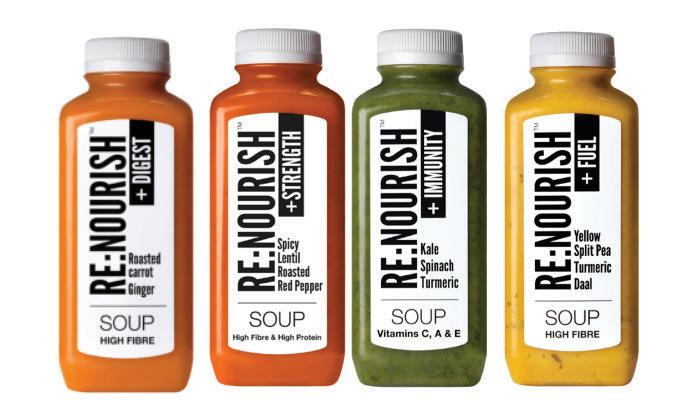
What inspired you to start this business?
Before starting Re:Nourish, I worked as a critical care nurse in a busy London hospital. I also have a background in nutrition and I’m a qualified reflexologist; health is at the core of my DNA. While working as a nurse, I realised the direct impact that patients’ diets have on their health, which ultimately led to me start Re:Nourish. I wanted to offer people a healthy,

gulfbusiness.com July 2022 69
JULY 22
a convenient options. Re:Nourish is now the fastest growing fresh soup brand in the UK, having grown 50 per cent in 2021.
Key milestones after starting your company
The Re:Nourish brand has enjoyed some exceptional highlights since our launch in 2019, but some really notable milestones include being stocked in a major UK supermarket and it’s stores – within just five months of launching. Another highlight is definitely our launch in Dubai, as part of our first international expansion. We’re currently available at Waitrose and Spinneys stores and will begin production in the UAE soon. We have managed to disrupt an $18.8bn soup category, as the only fresh global soup brand that is now available in five countries with many more exciting expansion plans to come.

You have developed the world’s first microwavable and recyclable bottle for soup. Tell us about it.
It took over nine months to design the
bottle. It took many prototypes and designs and even more sleepless nights, however, we got there in the end. I wanted to make sure that the Re:Nourish brand was sustainable. So, in order to achieve this, we do not mix the plastics and use polypropene not PET to make the cap, label and bottle – which make them recyclable. We are a carbon neutral brand and work hard to give back to the planet, with Re:Nourish currently contributing to a clean water initiative in India. We are also recycling ocean plastic in the Philippines.
As a brand, we want to be good for you and good for the planet too. All of our soups are fresh packed with goodness and free of any allergens. Each variety of soup has a unique health benefit, from our Immunity soup which is packed with vitamin C to our Digest soup that
is crammed with fresh ginger, which is wonderful in aiding digestion. We believe, as a brand, that food really is medicine and we strive to help people incorporate a little bit of extra goodness into their bodies and lives.
In November 2021, you secured a £2m investment. How are you using these funds to grow your business in the region and other markets? We are thrilled to have partnered with the Alshaya Group, who are now manufacturing our delicious soups in the UAE and helping us, as a brand, to grow in the UAE and Middle Eastern markets. We are using this investment on marketing, growing our team both in the UAE and internationally as well as launching in Australia and European countries imminently.
Sahar Karoubi, founder, Bambuyu What inspired you to start this business?

As a mother of two, I am constantly trying to evolve my own lifestyle as well as
raise my children to make informed and sustainable choices. About two years ago, I discovered that the toilet paper industry is responsible for cutting down 27,000 trees every single day; which influenced my decision to find an alternative. I quickly found that my options were extremely limited here in the UAE; and when I couldn’t find the product I wanted, I decided to do something about it. The idea for Bambuyu was born in March 2021 and by October that year, we had launched our first product: Bambuyu Planet-Friendly Toilet Paper.
I worked for 10 years in the digital industry, helping clients in the beauty and food sectors to build an online audience, allowing them to develop deeper and more meaningful relationships with their community.
What were some of the challenges you faced when starting o ?
We knew that one of the most powerful ways to combat the traditional
paper industry and allow some relief (and hopefully regeneration) to the forests was shi ting to bamboo, a renewable and sustainable source of paper. The challenge however was to find a valuealigned partner who could bring our vision to life. As a UAE-based brand, our priority was to manufacture our products locally. However, we found there
gulfbusiness.com70 July 2022
The SME Story
“WE DO NOT MIX THE PLASTICS AND USE POLYPROPENE NOT PET TO MAKE THE CAP, LABEL AND BOTTLE –WHICH MAKE THEM RECYCLABLE. WE ALSO ARE CARBON NEUTRAL BRAND AND WORK HARD TO GIVE BACK TO THE PLANET, WITH RE:NOURISH CURRENTLY CONTRIBUTING TO A CLEAN WATER INITIATIVE IN INDIA. WE ARE ALSO RECYCLING OCEAN PLASTIC IN THE PHILIPPINES”
was limited know-how and infrastruc ture around bamboo paper manufactur ing, and sustainable packaging options were limited. Covid-19 travel limitations and supply chain issues certainly slowed things down as well. We’ve been blessed to have a purpose that we truly believe in so we try to view these challenges as learning opportunities.
Tell us about your key milestones. As a startup, we celebrate all wins, big or small. In October 2021, we launched our D2C platform, allowing us to build relationships directly with our customers. We understand the power of the right platforms though, so we have also listed our products on Kibsons as we feel they are value aligned with what we are trying to do. We are also very excited to be launching in some more traditional
bricks-and-mortar retail channels in the last quarter of the year.
Tell us about your offering, its USP and business model.
Bambuyu reimagines toilet paper by combining sustainability and style and introduces a plastic-free, tree-free, alternative to battle deforestation –all wrapped in thoughtfully designed packaging. While most mainstream brands use virgin wood pulp to make their rolls, we rely on 100 per cent bamboo fibre. Bamboo is the world’s fastest-growing grass and in fact, grows 30 times faster than trees. It does not require planting after harvest, making it a renewable plant and raw material.
We’re here to give the transparency the industry desperately needs and move with our planet and customers’
27,000
ever-changing needs. Bambuyu provides a simple switch for consumers who are looking to shop more sustainably while continuing to enjoy premium quality.

Tell us about the response to your products in the UAE.
The moment we launched, we had our proof of concept, generating orders mostly organically through social chan nels. The most important metric that we monitor daily is our retention rate. We want to empower people to make the changes they want to see in the world in their everyday lives, and what better indicator than a returning customer.
How did you secure funding for your project?
Bambuyu is fully self-funded. It is far too early to invite partners and investors in, as we want to make sure we are building our growth around what matters to our purpose, not as an investment story.
Tell us about your future plans. From a product perspective, we are very excited to expand from a single-product brand to a full range of tree-free and plastic-free household paper products designed to complement all spaces of the house. Our bamboo kitchen rolls and facial tissues will be available across the UAE this summer.
Our efforts to support businesses across the UAE on their sustainability ini tiatives have significantly increased. We are able to service the food and bever age, and hospitality sector with the entire paper range. Some of our current clients are Scalini, operated by Bulldozer Group, and Alkalime, a homegrown restaurant and wellness space.
While it is exciting to think about geo graphical expansion, we are committed to serving the UAE market and feel we still have a long way to go, both in terms of growth as well as our efforts to create awareness on the impact of toilet paper manufacturing on forests.
gulfbusiness.com July 2022 71 The SME Story
“BAMBUYU REIMAGINES TOILET PAPER BY COMBINING SUSTAINABILITY AND STYLE AND INTRODUCES A PLASTIC-FREE, TREE-FREE, ALTERNATIVE TO BATTLE DEFORESTATION – ALL WRAPPED IN THOUGHTFULLY DESIGNED PACKAGING. WHILE MOST MAINSTREAM BRANDS USE VIRGIN WOOD PULP TO MAKE THEIR ROLLS, BAMBUYU RELIES ON 100 PER CENT BAMBOO FIBRE”
TREES ON A DAILY BASIS
THE TOILET PAPER INDUSTRY IS RESPONSIBLE FOR THE FELLING OF
A golden age of growth
TheMiddle East and North Africa
(MENA) comprises a robust startup ecosystem, which has become a foundation of healthy economic development. The ecosystem was propelled forward by one of the world’s youngest populations, in conjunction with increasing digital penetration, reaching 77 per cent smartphone penetration in 2021, and one of the fastest-growing e-commerce markets globally which grew at 33 per cent CAGR between 2014 and 2021.
Despite several challenges facing startups in the region, the number of successful

ventures has significantly expanded, attracting foreign capital from leading growth capital firms from the likes of Kleiner Perkins, General Atlantic, Tiger Global, Prosus to Delivery Hero, among others. Furthermore, a significant impetus from government organisations has contributed to this expansion, either from a fund of funds scheme or regulatory perspective

(For e.g., UAE’s pioneer crypto regulation, Saudi Arabia’s sandbox, Central Bank of Egypt’s push for digitisation, and a noncash economy). These developments have established a resilient ecosystem over time,
and startups have witnessed significant funding rounds, leading to much more active mergers and acquisitions, and initial public o ering markets.
EXPANSION OF THE ECOSYSTEM
Overall, the startup ecosystem’s expansion in emerging markets, including the MENA region, generated thousands of jobs tailored for white collar as well as low to middleincome populations.

Despite having much weaker research and development capabilities, the region’s startup dynamism and eagerness to innovate have propelled the emergence of homegrown innovative business models as opposed to traditional copy-cat models such as B2B marketplaces focused on grocery shops or digital ledgers.
In addition, a plethora of regional success stories, including Careem, Kitopi, Swvl, MNT-Halan, Anghami, Souq.com and Jahez, are starting to graduate their own talented employees who are subsequently building innovative ventures that are prone to scale. In this case I reference a group of former Careem employees who have since founded their own tech startups.
A few years ago, it was challenging for startups to secure significant funding across their cycle. Series A rounds of
gulfbusiness.com72 July 2022 The SME Story
Walid Hanna, founder and CEO, Middle East Venture Partners
COMMENT We explore how the region’s dynamism and eagerness to innovate have propelled the growth of unique homegrown business models
$941m $680m $862m $914m $1.031bn $2.6bn $934m 2016 2017 2018 2019 2020 2021 Q1 2022 201 333 442 573 496 590 79 TOTAL MENA FUNDING AND NUMBER OF DEALS funding deals
Source:
Magnitt, Wamda
FUNDING

over $15m were sporadic due to a small presence of regional investors and limited capital. Today, the amount of funding in the venture capital (VC) asset class has been increasing exponentially, accumulating a total of $934m in Q1 2022, which is almost as high as the total funding in 2020. Nevertheless, the market has still room for a larger number of investors and capital; especially from a VC investment percentage to GDP standpoint.
FACTORS INFLUENCING FUNDING
Securing funding at the Series A and Series B levels is becoming much more accessible, but it remains challenging at subsequent stages. This is gradually improving as multiple latestage global investors are starting to become active in the region, enabling startups to raise large rounds. For instance, Rain raised a $110m Series B round led by Paradigm and Kleiner Perkins. A total of 182 deals closed by startups in 2021 included a foreign investor participating (~30 per cent of total transactions). As VC matures in the region, exit frequency increases, with exit scenarios such as an IPO or an acquisition becoming more feasible. This creates a flywheel effect, where larger funds are becoming increasingly interested in the market.
EXITS IN MENA SINCE 2012
The MENA region’s three most active markets are UAE, Saudi Arabia and Egypt. In March, UAE was the leader in terms of funding amounts, attracting a total of $152m in March alone, mainly driven by large funding rounds such as Altibbi, which is currently in UAE but has a back office in Jordan and looking to relocate its headquarters to Saudi Arabia, and Tabby. Egypt and Saudi Arabia followed the UAE with a total of $86m and $39m
in March, respectively. Predominantly, the funding rounds went mainly to early-stage startups in March 2022 with less than 10 per cent of the transaction being of Series A stage or later.

EXAMINING STARTUP FUNDING
By assessing different industries, we notice that fintech startups accounted for 45 per cent of the total funding amount in March 2022, even though they face several regulatory hurdles, and it is often challenging to acquire a licence. Most of these initiatives aim to address the difficulties encountered by the unbanked and underbanked population with limited access to credit.
Moreover, the region’s healthcare infra structure remains underdeveloped, facing challenges that can be resolved mainly by digitisation. This resulted in 15 per cent of total funding dedicated to healthtech in March. In addition, the logistics sector attracted 13 per cent of the funding in March, as MENA faces several infrastructural challenges, plagued by an inefficient and fragmented value chain. Other sectors
have been receiving a significant amount of funding as well, such as foodtech, marketplaces, on-demand, proptech, media and mobility.

FUTURE OUTLOOK
Looking ahead, we anticipate that the decline in public markets will significantly impact VC funds globally since the region has started to see a decrease in deployment, forcing startups to decrease burn and lower their valuations. Nonetheless, we are confident that the MENA startup ecosystem will be resilient, propelled by strong drivers and a precise alignment with stakeholders. As Warren Buffet said: “Be fearful when others are greedy and greedy when others are fearful.”
Ultimately, the current market slow down will enable startups to optimise their unit economics and concentrate on sus tained growth. Considering that the typical VC cycle is 10 years, it is an excellent opportunity to invest during bear markets and generate profits during uptrends.
gulfbusiness.com July 2022 73 The SME Story
“ULTIMATELY, THE CURRENT MARKET SLOWDOWN WILL ENABLE STARTUPS TO OPTIMISE THEIR UNIT ECONOMICS AND CONCENTRATE ON SUSTAINED GROWTH”
0.04% 0.39% 0.42% 0.80% SHARE OF VC
AS A PERCENTAGE OF GDP, 2020 MENA 0.8 0.7 0.6 0.5 0.4 0.3 0.2 0.1 0 CHINA
INDIA
US Source: World Bank, MEVP Research 21X
THE
UAE
WAS THE LEADER IN TERMS OF FUNDING AMOUNTS, ATTRACTING A TOTAL OF
$152 m IN
MARCH ALONE
Peter Heredia, managing director - MaxSales Solutions, sales coach and author

The right call
Showcasing your product or service can be a challenge particularly if you are a small- or medium-sized company. Getting your foot in the door starts with making the right impression on your very first call
Don’t say that, say this...
Here are some common sales call openers:
• “I’d like to arrange to meet you to see how we can work together.”
•
“It would be great to meet up to provide you with an overview of our company.”
On what planet would your prospect be interested in what you want? Rethink your opener to be more prospect-themed. Your reasons on why they’d be interested in what you have to say will depend on their industry, but examples that we’ve found have worked well are:
•
“Would you be free for 30 minutes so I can give you an industry update that specifically relates to your operations in Saudi Arabia?”
• “If you have 30 minutes next week, may I update you on the new tech that’s helped companies in your sector significantly improve productivity?”
It’s
easy to believe that the most important stage in any sales process is making that (hopefully) winning proposal. But we can’t ever get to that stage without first get ting that “oh-so-important” first meeting.
Prioritising the activities that secure more first meetings can have a revolutionary impact on a company’s sales pipeline. Sometimes even little improvements in calls with prospec tive clients can have big results.
Let’s see how it works (in real life):
If we secure eight meetings out of 40 calls, with a 25 per cent closing ratio and average deal value of $10,000, we would win two deals, or $20,000 in sales.
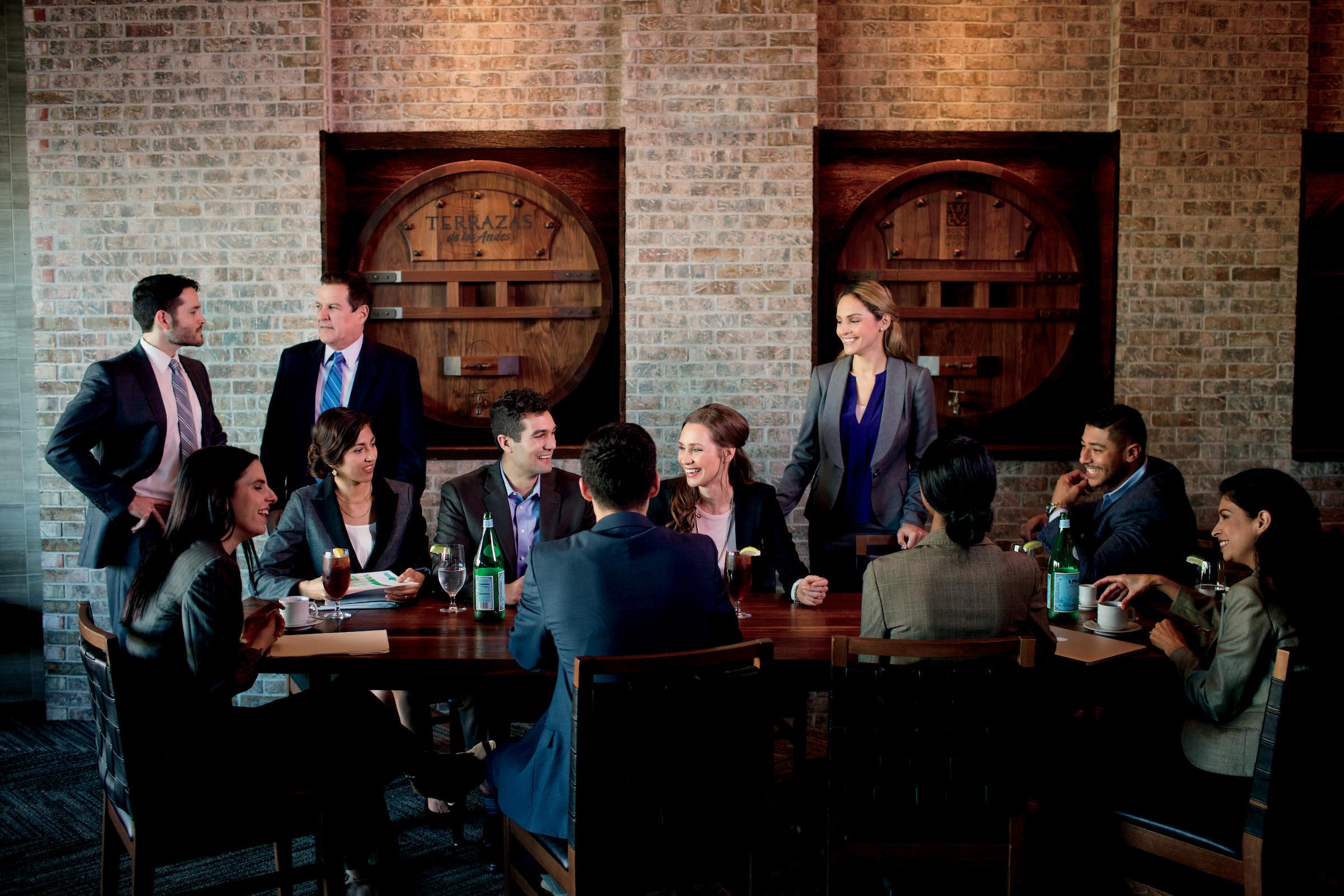
If we took action to improve our calls and start securing 12 meetings out of 40 calls, we would win three deals, or $30,000 in sales.
That’s a 50 per cent increase in new business revenue – just by getting better at how you tackle your phone calls.
Don’t take it too lightly
So, as an example let’s say you are a small or medium sized-company looking to make a breakthrough into an another company that can really make a difference
to your success. You have been introduced by a mutual contact and they are aware you may be calling, but there is still lots of work to be done. They will still have to agree to meet you.
There’s generally little focus and effort put into those first calls, and this is a mistake. If we, as salespeople, are in the business of persuasion, we need to focus all our skills of persuasion from the very start of the sales process, rather than wait until we’re face-to-face with our prospects.
The sales call: what are you trying to achieve
We only have one objective – and that‘s to get our prospect to agree to see us. So we need to make it easy for them to say “yes”. We can do it by being totally prospectfocused, and that means:
• Making it very low commitment for them.
• Offering something that’s worthwhile to them.
Think through why our prospect should give us any of their valuable time. What’s in it for them? Even a little more effort in this area can have a massive and positive impact on our sales.
A period of 30 minutes is low commitment for your prospect, and you’ve angled it as something specific and worthwhile that they might get some real benefit from. You’ve got a higher chance of getting that first meeting. And when you meet with them, you’ll give them that worthwhile something and you’ll have built credibility, which helps you achieve the next stage of the sales process.
Stick to the point
It’s important to be confident, prospectfocused and polite, of course, but think through how you frame what you say, to give your prospect fewer opportunities to turn you down, for example:
• Don’t ask if they have time to talk. It’s easy for them to say no. You can still be very polite, but avoid an immediate rejection.
• Don’t waffle: focus only on offering the information that’s enough for them to say yes to a meeting.
• Suggest a time for the meeting, or give two options only. This narrows your prospect’s stream of thought and the opportunity to decline a meeting.
• Keep your introduction to 20 seconds.
Improving your sales calls in small ways can have a big impact on your new business sales, so it’s worth reviewing what you’re doing now, and making those improvements.

gulfbusiness.com74 July 2022 The SME Story


C O R P O R A T E D I N I N G WE TAKE CARE OF YOUR EVENT -Private Rooms & No Rental Fees Special Group Packages A Feast of Fire Roasted Meat Cuts - Indulgent Options to Impress your Guests -Vegan / Vegetarian Options CENTRAL PARK TOWERS DIFC P3, RSVP 043438867 WHATSAPP +971 50 5089110
















































 The United Arab Emirates 50th Anniversary Navigator Clock – Limited Edition by David Galbraith
Painting by Sonu Sultania
Photograph by Jorge Ferrari
The United Arab Emirates 50th Anniversary Navigator Clock – Limited Edition by David Galbraith
Painting by Sonu Sultania
Photograph by Jorge Ferrari











 Riad Bsaibes, president and CEO, Amana Investments
Riad Bsaibes, president and CEO, Amana Investments

















































































































 Louay Dahmash
Louay Dahmash


























































 Alaa Saoudi
Alaa Saoudi










 By Zubina Ahmed
By Zubina Ahmed



































































 BY ZUBINA AHMED
BY ZUBINA AHMED





 BY NEESHA SALIAN
BY NEESHA SALIAN














 WORDS: ZAINAB MANSOOR
WORDS: ZAINAB MANSOOR


























